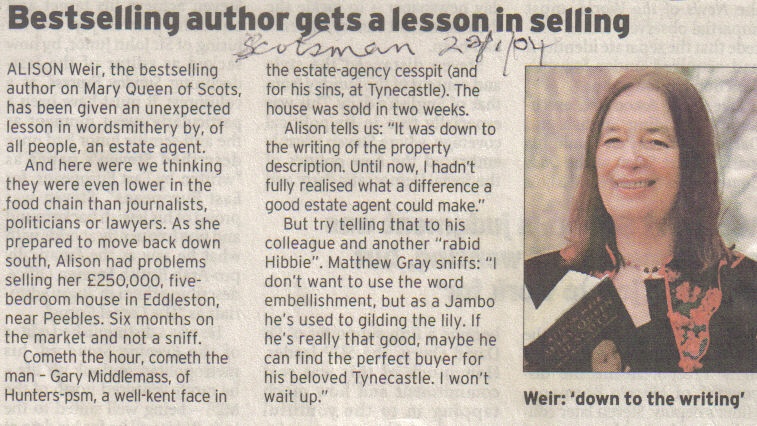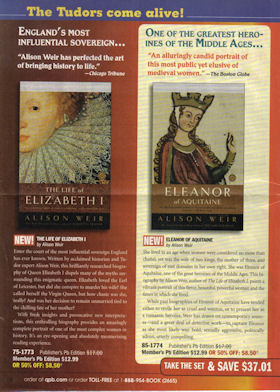Miscellany
A WRITER'S LIFE IN LOCKDOWN
Article for the 125th and final issue of the City of London School for Girls Olds Girls' Asociation


KATHERINE OF ARAGON AT CROYDON PALACE
It is often stated that Henry VIII’s first queen, Katherine of Aragon, lived At Durham House, the Bishop of Durham’s palace on London’s Strand, after the death of her first husband, Arthur Tudor, Prince of Wales in April 1502. In fact, Henry VII gave the young widow - she was sixteen - the choice of two residences: Durham House and Croydon Palace, the Archbishop of Canterbury’s residence in Surrey. Katherine chose Croydon and, by 4 May, was lodging there.
At that time, Croydon Palace was a large, stately courtyard house with opulent chambers, a great hall, a chapel and a great parlour. There had been archiepiscopal buildings on the site since the tenth century. Since the archbishops used the palace as a summer residence, Katherine was probably accommodated in their own chambers, which had recently been partially rebuilt.
Late in May, the Queen, Elizabeth of York, sent her page, to Croydon, possibly to check on the Princess’s health, and perhaps discreetly to ask her servants if there were signs of any pregnancy.
During the months Katherine stayed at Croydon, her future remained under discussion. Her parents, the Spanish sovereigns, Ferdinand and Isabella, were naturally concerned about her. On 10 May they had sent an ambassador to England with instructions to preserve their alliance with Henry VII, ask for the immediate return of Katherine and her dowry and, if possible, secure the Princess’s betrothal to the new heir to the throne, Prince Henry, who, at eleven, was five years her junior. Everyone was aware that, if Katherine had conceived a child by Arthur, her union with Henry would contravene canon law. Doña Elvira, her duenna, was adamant that the marriage had not even been consummated and wrote to Queen Isabella insisting that the Princess remained a virgin. In July, when it was beyond doubt that Katherine was not pregnant with Arthur’s child, Isabella informed Henry VII that her daughter remained a virgin. But, although Henry also wished to preserve the Spanish alliance, he was hesitant. Months would pass before he reached a decision on the proposed betrothal between Katherine and Henry. Meanwhile, with her future still uncertain, Katherine had moved to Durham House; she was living there by 6 November 1502.
Her stay at Croydon must have been shadowed by sorrow and anxiety. All her life, she had been brought up as a future queen of England; now that destiny had been stolen from her. It would be seven long, stressful, penurious years before it was restored to her and she became Henry VIII’s first wife.
The Old Palace is now a school and I know it well because my daughter was a pupil there.
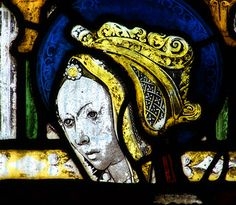
You can read my article on the portraits of Margaret Beaufort here at Art.UK: https://artuk.org/discover/stories/my-lady-the-kings-mother-images-of-margaret-beaufort

Beyond the Tower Walls (2020) - you can listen to the webinar here: https://www.youtube.com/watch?v=p7D2xWZAltw&feature=youtu.be
In October 2015 I was privileged to be invited to the Royal Courts of Justice in the Strand to speak at the City of London's annual Quit Rents Ceremony, an ancient ritual that dates back to the Middle Ages and takes place in the Lord Chief Justice's Court in the presence of the Queen's Remembrancer, the only surviving officer of the Court of the Exchequer. This was a very special event for me, as my links with the City go way back to the years when I was a pupil at the City of London School for Girls. The speech I gave is below:
THE LOST ROYAL HERITAGE OF THE CITY OF LONDON
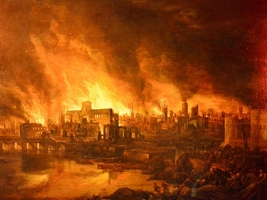
Before the Great Fire of London, the City of London boasted several royal residences and burial places. Today I am going to tell you about some that I’ve researched for my books, but which have mostly disappeared.
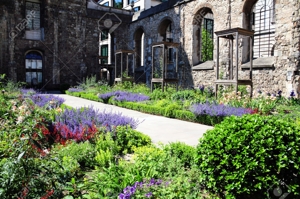
In Newgate Street stand the ruins of Christ Church, a stark reminder of the devastation caused by the Blitz of the Second World War. This is the site of Christ's Hospital, the Blue Coat School founded by Edward VI in the sixteenth century, destroyed during the Great Fire of 1666 and rebuilt by Sir Christopher Wren. Yet these ruins stand on the site of an even older foundation, the magnificent monastery of the Grey Friars, originally founded in 1225.
Two French-born queens, Margaret, the second wife of Edward I, and Isabella, the wife of Edward II, had a special affection for this church and the Franciscan Order. Margaret asked for the new church to be modelled on the lines of the Church of the Cordeliers in Paris, which had been founded St Louis, King of France, around 1250, and there was a chapel dedicated to St Louis at Newgate. Isabella paid handsomely towards the completion of the church, which, when finished in 1348, measured a grand 300 feet long by 89 feet wide, making it second only to St Paul's Cathedral in size. It was a beautiful light and spacious building, and thanks to the patronage of these two queens and other royal ladies, it remained the most prestigious Franciscan house in England, and the most fashionable church in London, for the next two centuries.
In the fourteenth century, this was a royal mausoleum set to rival Westminster Abbey as the resting place of crowned heads, yet tragically its splendours, including the tombs of Margaret and Isabella, are long gone, having disappeared after Henry VIII dissolved the monastery in 1538, during the Reformation. Isabella was – undeservedly, I think - one of most notorious femmes fatales in history. Popular legend has it that her angry ghost can sometimes be glimpsed amid the ruins, clutching the heart of murdered husband to her breast. But if he was murdered – and that’s another story – it’s unlikely that she was involved.
Nearby once stood the ancient collegiate church and monastery of St Martin le Grand, founded around 1056 in the reign of Edward the Confessor. It was within the City, but was not subject to its jurisdiction, being a liberty with the privilege of sanctuary. St Martin’s was responsible for the sounding of the curfew bell in the evenings, which announced the closing of the City's gates. The monastery was dissolved by Henry VIII and demolished in 1548.
In 1472, Edward IV’s brother, Shakespeare’s ‘false, fleeting perjur’d’ Duke of Clarence, hid away his wife’s sister, Anne Neville, as a kitchen maid in his London house, the Erber, to prevent his brother, the future Richard III from marrying her and securing her inheritance, which Clarence wanted for himself. But Richard tracked her down, rescued her and placed her in the sanctuary of St Martin le Grand until their marriage could be arranged. Another who sought sanctuary here was Miles Forrest, one of the reputed murderers of the Princes in the Tower. Here, according to Thomas More, Forrest ‘rotted piecemeal away’ and died within a year.
John of Gaunt, Duke of Lancaster, fourth son of Edward III, was the mightiest magnate in England, but in 1381 his great palace of the Savoy on the Strand was burned down during the Peasants’ Revolt. By 1391 he had leased Ely Place in the fashionable suburb of Holborn, just beyond the City boundary. But for centuries the Bishops of Ely lent their hall for the festive gatherings of the newly-elected serjeants at law.
Since 1286, Ely Place had been the town house of the bishops of Ely. There has been a building on the site since the sixth century, and parts of the walls that survive today date from the 1100s, being eight feet thick. To the north of the palace site is Bleeding Heart Yard, the name of which has nothing do with John of Gaunt but commemorates a murder in 1626; and to the west is Ely Court, where lies the Mitre Tavern, founded in 1546. Outside is a cherry tree around which Queen Elizabeth was said to have danced.
Recently rebuilt above the remains of the older house, the property leased by John of Gaunt was a large and imposing palace with 'commodious rooms'. Its extensive gardens were famous for their roses and strawberries, the latter being mentioned in Shakespeare's Richard III; there was also a vineyard. A massive stone gatehouse adorned with the Bishop's arms fronted the street.
Within the palace complex was the bishops' magnificent private chapel, dedicated to the Saxon St Etheldreda and completed around 1300. A Catholic church since the 1870s, it was extensively rebuilt both before and after suffering severe bomb damage during the Second World War, but the crypt survives from John of Gaunt’s time - all that is left of the great palace that remained his London residence for the rest of his life.
In the late sixteenth century Elizabeth I forced the Bishop of Lincoln to surrender Ely Place to the Crown. Sir Christopher Hatton then acquired the freehold – hence the name of the nearby street, Hatton Garden. The old palace was demolished in 1772, when the present Ely Place – a gated cul-de-sac of Georgian houses – was built. It incorporates the church of St Etheldreda.

Old St Paul's Cathedral, which was destroyed in the Great Fire of 1666, was the largest building in mediaeval England. It was completed in 1220, on the site of an earlier church founded around 607 by King Ethelbert of Kent, which burned down in 1087. The new stone cathedral in the Romanesque style was truly awe-inspiring: the steeple was 520 feet high and the spire was 260 feet. The church was 720 feet long and 130 feet wide. Thus it was longer than the present St Paul's, and its spire taller than that of Salisbury Cathedral, the highest in England today.
The interment of Blanche of Lancaster, the first wife of John of Gaunt, in 1368, was the first royal burial in St Paul's since that of the Saxon King Ethelred the Unraed in 1016; in Gaunt's day, Ethelred’s massive stone sarcophagus could still be seen in the north quire aisle. Behind the high altar stood the magnificent shrine of St Erkenwald, a seventh-century Bishop of London.
In 1399 John of Gaunt himself was buried in Old St Paul’s Cathedral. His body was brought from Leicester to the Church of the Carmelites, south of Fleet Street. Today, an inn, the Old Cheshire Cheese in Wine Office Court, stands on the site of the Whitefriars' guesthouse where his widow, Katherine Swynford, may have lodged. On Passion Sunday, in the presence of King Richard II and all the nobility, Gaunt was laid to rest with great honours beside Blanche in an 'incomparable sepulchre' near the high altar. During the Wars of the Roses the tomb was defaced and the painted alabaster effigies destroyed. Gaunt’s great-great grandson, Henry VII, had the tomb restored. In 1614 it was described as 'a most stately monument, but when Old St Paul's Cathedral was destroyed in Great Fire of London, John of Gaunt's tomb was 'burnt to ashes’. It is unlikely, therefore, that the corpses of John and Blanche were among those that were dragged from the ruins and propped up in Convocation House Yard for passers-by to gawp at.
If you were surveying the Thames riverfront in London over four hundred years ago, and were standing on the south bank outside the Tate Modern, you would have seen on the opposite side of the river a large palace with turrets and a water gate.
This was Baynard’s Castle, originally one of three fortresses built by William the Conqueror to defend London. The original Baynard’s Castle was a Norman stronghold that stood slightly inland, but this was demolished around 1276 to enable the Black Friars to extend their monastery – the monastery where in 1529 Katherine of Aragon went on her knees before Henry VIII and begged him to spare her the extremity of a divorce court.
In 1338 Baynard’s Castle was described as a ‘tower on the Thames by the place called Chastel Baynard’. After a serious fire in 1428 it was rebuilt on land reclaimed from the river by Humphrey, Duke of Gloucester, brother of Henry V. On the death of Duke Humphrey in 1447, it passed to Henry VI who granted it to Richard, Duke of York. In 1461 York’s son, Edward IV, was offered the crown of England in the great hall of Baynard’s Castle; and there, in June 1483, Edward’s brother, Richard, Duke of Gloucester was proclaimed King Richard III. In 1485 Baynard’s Castle passed to Henry VII, who transformed it into an imposing royal residence and granted it to his Queen, Elizabeth of York. By then it was a massive white stone edifice with tall towers, rising majestically from the Thames.
In 1509, Elizabeth’s son, Henry VIII, gave the castle to his bride, Katherine of Aragon. It continued to be an important royal palace until 1551, when Edward VI presented it to William Herbert, Earl of Pembroke. In 1666 the Great Fire of London destroyed much of the building; only one turret survived for another sixty years. The remains of Baynard’s Castle stayed below ground until 1972, when the construction of a new dual carriageway and flyover on the north bank of the Thames prompted a major rescue excavation. When the archaeologists had left the site, it was completely covered with new roads and modern buildings, and the foundations of Baynard’s Castle disappeared from view.
Looking at London’s skyline now, it is hard to imagine how in centuries past the turrets of the royal palace of Baynard’s Castle, rising vertically from the waters of the Thames, would have completely dominated the north side of the riverfront.
Another great mansion, Coldharbour, built in the fourteenth century, stood on the northern foreshore of the Thames. Among its famous residents were Henry IV, Henry V, Sir John de Pulteney - four times mayor of London and builder of Penshurst Place - and Alice Perrers, Edward III's notorious mistress, who added a tower. In 1484 Richard III granted Coldharbour to the royal heralds, but they held it for just a year, until Richard III was killed at Bosworth and Henry VII cancelled the grant of Coldharbour, which he gave to his mother, Margaret Beaufort. Coldharbour also was burned down in 1666 during the Great Fire.
I could add so much more, from the state trials in Guildhall to the wonderful history of St Bartholemew’s – the list would be endless, but contemplating these lost buildings, and the rich heritage that has gone, it is easy to see why the poet William Dunbar wrote, around 1500, ‘London, thou art the flower of cities all!’
Read historical novelist Anne Clinard Barnhill's very kind article, 'Alison Weir and Me', at http://queenanneboleyn.com/2013/10/30/alison-weir-and-me-by-anne-clinard-barnhill/
"THE AMAZING BEST SELLING AUTHOR ALISON WEIR"
(Broadway to Vegas, September 2012)
Those Tudors were an amazing group. Sex, murder, mistresses, intrigue. A dysfunctional family if there ever was one. But, oh, so interesting. Riveting as brought to life by best-selling author Alison Weir, who spoke with Broadway To Vegas about her own interesting life, as well as the antics of those who flow from her prolific pen. Her history books, and latterly historical novels, mostly in the form of biographies about British royalty from the Tudor period have made her a best-selling author.
The Tudor period was dramatic, vivid with strong female personalities. It is also the first one for which there is a rich visual record, with the growth of portraiture, and detailed sources on the private lives of kings and queens.
Weir has sold more than 2.3 million books: with more than a million of those sales coming from the United States. She is also the 5th best selling historian in the United Kingdom. The top four are Antony Beevor, Stephen Ambrose, Simon Schama and Peter Ackroyd.
Weir's fourth novel, A Dangerous Inheritance, is the stand-alone sequel to Innocent Traitor. It tells the story of Lady Katherine Grey, and is a suspenseful tale about one of history's most controversial mysteries, approached from a new angle in an intriguing sub-plot, with a hint of the supernatural. The paperback edition of Alison's latest biography, Mary Boleyn, was published in America on September 4, 2012.
Weir specializes in writing about a century of raw power and rude humor. As to whether any of the relatives of figures in her books have contacted her with their opinions, Weir replied: "Anya Seton's daughter contacted me after I had written an appendix about her mother's novel, Katherine, in my biography of Katherine Swynford. She was happy with my portrayal of her mother and said I'd got it mostly right!"
Some people not only appear to have it all, but make it look so easy. Underneath the success is a lot of talent and tenacity.
Meet the personal side of Alison Weir. Born and bred at Westminster, London, she has also lived in Norfolk, Sussex and Scotland, and now resides in Surrey.
'My parents split up when I was young, and my father died many years ago," Weir told Broadway To Vegas. "He instilled in me a love of classical history when I was a child, and introduced me to the works of Robert Graves and Mary Renault."
Weir has been interested in Tudor history since the age of fourteen, when she read her first adult novel, a rather lurid book called Henry's Golden Queen, about Katherine of Aragon. She was so enthralled by it that she dashed off to read real history books, to find out the truth behind what she had read, and thus her passion for history was born. By the time she was fifteen, she had written a three-volume reference work on the Tudor dynasty, a biography of Anne Boleyn based partly on contemporary sources, and several historical plays. She had also started work on the research that would one day take form as her first published book, Britain's Royal Families.
Alison was educated at the City of London School for Girls and the North Western Polytechnic, training to be a teacher with a major in history. However, she quickly became disillusioned with trendy teaching methods. Before becoming a published author in 1989, she was a civil servant, then a housewife and mother.
It should come as no surprise that super-mom Alison Weir did what a lot of mothers are required to do - rise to the occasion.
From 1991 to 1997, while researching and writing books, she also ran her own school for children with learning difficulties. "My son has special needs and we couldn't find a suitable school for him," she told Broadway To Vegas. "So, I set up my own!"
She's been married to Rankin Weir since 1972, and they have two children, John who was born in 1982 and Kate who came along in 1984. "My husband was a civil servant until 2001; since then, he has worked for me. He is the bedrock of our lives - I couldn't do this without him," she stressed. "My children, indeed my whole family, are all marvelously supportive."
Alison Weir will take part in a book reading and signing of Captive Queen on September 28 to benefit the The Friends of Northampton Castle, a volunteer group established to publicize the castle and provide information about the history of the site and the castle itself. In July 2012, FONC commissioned a 3D reconstruction of the castle which has been published on youtube. Thomas Becket was tried at the castle in 1164.
Being an organized pack rat can be important to a successful author. "I save most things, and yes, I have used a huge amount of my earlier research in my books," she said answering a Broadway To Vegas question. "I'm now rewriting two early novels, and am about to base a book on England's medieval queens on research I did four decades ago."
In the 1970s, Weir spent four years researching and writing a non-fiction biography of the six wives of Henry VIII. Her work was deemed too long by publishers, and was consequently rejected. A revised version of this biography would later be published as her second book, The Six Wives of Henry VIII.
In 1981, she wrote a book on Jane Seymour, which was again rejected by publishers, this time because it was too short. Weir became a published author in 1989 with the publication of Britain's Royal Families, a compilation of genealogical information about the British Royal Family. She revised the work eight times over a twenty-two year period, and decided that it might be "of interest to others".
What Weir's writing has done to encourage an interest in history is magnificent. However, she hasn't attempted to get her books turned into movies or a PBS special because, frankly, "Normally, broadcasting companies approach me."
Those who are successful authors of romance novels know there is a formula. What about historical fiction? "It all depends on your publisher, and editors vary widely in their opinions," she answered. "I was given a lot of excellent advice (e.g. show, rather than tell), so I do bear that in mind, but by now it's virtually become second nature."
As to whether she has a favorite character that she'd would like to spin off into a series of books, Weir replied: "Not yet, but I'm thinking about it! A female detective who solves historical mysteries would sing to me!"
Weir's writings have been describing as being in the genre of popular history, which has attracted criticism from academia.
Weir is not apologetic. "History is full of wonderful stories and amazing characters. I feel very privileged to be able to bring them to life in both my non-fiction books and my novels. In both cases, I feel that an author has a responsibility to be as true to the facts as is possible. And in an age in which history is increasingly perceived to be 'dumbed down' in schools, on television and on film, we can all learn from a study of the past. We can discover more about ourselves and our own civilization.
"History belongs to us all, and it can be accessed by us all. And if writing it in a way that is accessible and entertaining, as well as conscientiously researched, can be described as popular, then, yes, I am a popular historian, and am proud and happy to be one."
THE WHITE ROSE OF SCOTLAND
A NOVEL OF LADY KATHERINE GORDON
(Unsubmitted proposal, 2014. This book was also proposed as a biography.)
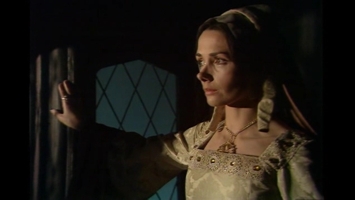
Perkin Warbeck; Elizabeth MacLennan as Katherine Gordon in the BBC TV series 'The Shadow of the Tower' (1972). No contempory image of Katherine exists.
Lady Katherine Gordon is the daughter of a Scots nobleman, George Gordon, Earl of Huntly. She was born in Aberdeenshire in 1474. Her story begins when she is brought to the court of King James IV at Stirling Castle in November 1495. James has welcomed a controversial young man to his court. Handsome and gallant, the newcomer insists he is Richard, Duke of York, the younger of the Princes in the Tower (whom many believed to have been murdered twelve years earlier) – and therefore Richard IV, the rightful King of England. Wishing to discountenance his enemy, Henry VII of England, James has offered Richard his support and received him with royal honours, and offered him his kinswoman, Katherine, a young lady of extraordinary beauty, to be his bride.
Richard proves an ardent suitor, sending her passionate letters, and she falls in love with him. They marry in Edinburgh the following January, amidst great celebrations. Katherine is now styled the Duchess of York. One day, she dreams, she will be queen of England.
A son, Richard, is born to them nine months later. Meanwhile, plans have been laid for Katherine's new husband to invade England. While Katherine lies abed recovering from her confinement, James and Richard ride into Northumberland, where Richard issues a proclamation as king of England. But no Englishmen rally to his banner. When the Scots start raiding Northumberland and engaging in border warfare, Richard excites ridicule by entreating James to spare those whom he calls his subjects. Richard is so disgusted by the mayhem that he returns to Scotland after three days, leaving James with no option but to follow.
By July 1497 Henry VII has begun peace negotiations with James, which makes it impossible for Richard to stay in Scotland. Leaving many debts behind, he and Katherine embark with their two children from Ayr in a Breton merchant vessel. The plan is to land in England and seize the English crown, but Richard has no weapons or soldiers.
First they visit Cork, remaining in Ireland more than a month. But Richard fails to rally any support there. Instead the citizens of Waterford fit out vessels at their own cost, and nearly capture him at sea during his crossing to Cornwall. When Richard and Katherine land at Whitesand Bay in Cornwall, he proclaims himself King Richard IV of England, and installs Katherine within the safety of the castle on St Michael's Mount. At Bodmin, he raises three thousand men, with more joining him on his march eastward. Katherine waits in trepidation to hear news of him. Her youngest child has been ailing, and she fears for her life. Then news comes that Richard has been forced to withdraw to Taunton after failing to take Exeter. That same day, her child dies, and she is plunged into mourning.
Then news comes that the King’s army is on the march. Fearful for her son’s safety she arranges for him secretly to be taken to Wales and hidden in a humble farmstead. Soon afterwards she hears that, abandoned by his followers, Richard has surrendered himself to the King's mercy.
Soon the royal soldiers come for Katherine. They tell her that her husband, having been promised his life, has made a full confession of his imposture. He is really Perkin Warbeck, the son of the Controller of Tournai, and he had been persuaded by the Irish to impersonate Richard of York. Katherine is now the King’s prisoner and is to be brought to him at Taunton. Her fears are somewhat allayed when she is provided with mourning attire for her child.
As she rides to Taunton, she wonders if Richard has merely repeated what he was told to say. With his wife – and, he believes, his child - in Henry’s custody, he has little choice. Not knowing what to think, she is in turmoil – and terrified in case Richard (the name she will always call him) will reveal that he has a son, forcing her to divulge the child’s whereabouts.
When Katherine comes into Henry’s presence, he is struck by her beauty and is more than kind to her. Deferring to her rank, he pays her much attention; it seems he feels sorry for her for having married an imposter. He summons Richard and makes him repeat his confession in her presence. Now she is even less sure what to believe.
Henry sends Katherine, under escort, to his Queen, the kind and gentle Elizabeth of York, assuring her of his desire to treat her like a sister. Richard is taken under guard to London, an object of ridicule. At first, he is imprisoned in the Tower, but after publicly repeating his confession in London, he is allowed to live at court. He begs Henry to send Katherine home to Scotland, and even James IV tries to gain her freedom, but Henry fears more plotting will ensue; he has also taken a fancy to Katherine.
Richard is given a place in Henry's household. He is under light house arrest, and has his own servants, a horse and a tailor. He is allowed to see Katherine, but not to sleep with her. She warns him not to reveal that they brought a child out of Scotland. Rightly she fears that any son of the pretender would be in danger, and might be shut up in the Tower like the young Earl of Warwick, who is too near in blood to the throne.
Katherine is made very welcome in Elizabeth of York's household, and becomes a favoured lady-in-waiting. She resumes her maiden name of Gordon and is treated with all the deference due to her noble birth. Soon she is known popularly as ‘the White Rose of Scotland’. The King pays her expenses from his own privy purse. He awards her a pension and gives her lavish clothing. She knows what he wants, and is tempted because she has come to like this man who was once her enemy.
After a year, Richard grows tired of his silken chains and escapes from the court to Sheen Abbey, but the prior informs the King that he is there. This time, Richard is imprisoned in the Tower for good, in a dark cell.
Henry has betrothed his heir, Prince Arthur, to Katherine of Aragon. Her parents, the Spanish sovereigns, will not let her come to England while the Earl of Warwick lives. Henry decides to kill two birds with one stone. An agent provocateur is planted in the Tower, and Richard and Warwick are drawn into a plot. In November 1499 Katherine, disguised, is watching in the crowd when Richard is executed.
After his death she remains at the English court. The King is still giving her lavish clothing. In 1503 she briefly returns to Scotland in the train of Henry’s daughter Margaret, to attend Margaret’s wedding to James IV. By now, Henry is a widower, and on Katherine’s return they become close, spending so much time together that there is speculation they will marry. But Henry is a sick man. He dies in 1509 and his son, Henry VIII, becomes king.
The new King is fond of Katherine, who was much loved by his mother. He appoints her a lady-in-waiting to his queen, Katharine of Aragon. The following year Katherine obtains letters of denization and becomes an English subject. The King grants her lands in Berkshire, on condition that she will not venture within 100 miles of the Scottish border. It is a strange condition to impose, and Katherine wonders if he has found out about her son. All these years she has suffered heartache on account of the boy, denying herself even a glimpse of him to ensure his safety. King Henry, more ruthless than his father, must never know of young Richard’s existence.
In 1512 Katherine marries James Strangeways, one of the King’s gentleman ushers. The Strangeways were once a Yorkist family. Although it is not a happy marriage, it brings Katherine the manor of Fyfield, Berkshire, with its rambling timbered house, which she comes to call home. Here she will live when not at court.
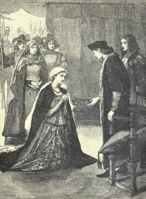
Katherine before Henry VII; Fyfield, Berkshire
In 1517 James Strangeways dies, leaving his estate to his wife. By then, Katherine has fallen in love with an older man, the kindly Sir Matthew Cradock, a Welsh gentleman who has secretly watched over her son for her. They marry soon after James’s death, and the King gives her leave to dwell with her husband in Wales. Cradock is a knight of some standing, and they lead a comfortable life, dividing their time between Cardiff, Swansea, Abertawe and haunted Candleston Castle, near to which there is said to be a lost village buried in the sand dunes. At last Katherine is able to see and get to know her son.
But Queen Katharine has not forgotten her. When her young daughter, the Princess Mary, is sent with her household to Ludlow Castle on the Welsh border in 1525, the Queen appoints Katherine chief lady of the Princess's privy chamber. Again, Katherine realizes she must be circumspect about her life in Wales. She serves the Princess until Mary is recalled to court in 1527. Henry VIII is divorcing Katharine of Aragon, and the Queen begs Katherine to stay with her daughter to support her during this difficult time. Reluctantly, Katherine returns to court, and Matthew takes a house in London. Neither of them are happy to see Anne Boleyn queening it over the court, or to see Mary so unhappy.
In 1530 Matthew’s health breaks down. Katherine is now fifty-six. Her son is a grown man, and she longs to see him again. The Queen gives her permission to go home, and the couple return to Wales. In July 1531 Matthew dies.
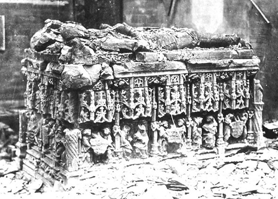
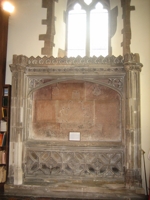
Matthew Cradock's bomb-damaged tomb in St Mary's Church, Swansea, now lost; Katherine Gordon's tomb in St Nicholas's Church, Fyfield.
Katherine retires to Fyfield, where she spends the last six years of her life; still beautiful, she becomes a familiar sight, riding her horse around the parish. In 1536 she marries for the fourth time, to a local man, Christopher Ashton, another royal gentleman usher. Nineteen years her junior, he is a widower, and Katherine becomes stepmother to his two young children. She dies at Fyfield in October 1537, much loved by her husband and all who know her.
What had happened to her son? That is one of the central themes of the book. There are hints that the real Katherine Gordon had a son by Perkin Warbeck, and that this Richard Perkins was sent to a family in Wales for safety. It is possible that Katherine spent her whole life concealing his existence, while retaining the affection and respect of the Tudor monarchs. Another theme in the book is how Katherine came to regard Perkin Warbeck, the only one of her husbands not to be mentioned in her will. Did she truly believe he was Richard of York? Or did she feel betrayed by his imposture? The third theme is the nature of her relationship with Henry VII. How close were they?
Katherine Gordon’s is an extraordinary story spanning two rich periods of history, two courts and all four corners of the British Isles. It is a tale of love, ambition, tragedy and intrigue – and of a beautiful and remarkable woman.
BRITAIN'S LOST QUEENS
by Alison Weir, 2012
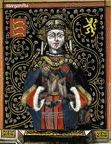



In the wake of the announcement that the Duke and Duchess of Cambridge are expecting their first child, and the new legislation to give their daughters equal precedence with their sons in the order of succession, it is interesting to speculate which princesses would have reigned in England had this law been enacted in past centuries, when several monarchs left daughters who were older than the sons who succeeded them.
Until Elizabeth I proved that a woman could rule successfully, the concept of a a female monarch was unacceptable to the male-dominated society of medieval and Tudor England. It was a world in which women were regarded as inferior to men physically, intellectually and morally, and were legally infants. It was seen as against the laws of God and Nature for a woman to wield dominion over men: such a thing was an affront to the perceived order of the world.
Setting aside such prejudices, and the necessity in earlier times for a ruler to be an active war leader, who were the queens England - and later Great Britain - never had?
In 1135, the Empress Matilda, daughter of Henry I, was actually her father’s thrice acknowledged heir, but on his death the barons opted for her cousin Stephen instead. Matilda launched a civil war in defence of her rights, but her bid for power failed in the face of her perceived arrogance, and the Londoners wasted no time in kicking her out.
In 1307, instead of the weak and vicious Edward II, there would have been Margaret I, former Duchess of Brabant, the eldest surviving daughter of Edward I. She is a shadowy figure about whom there is little to say, but her accession would have seen closer links with the Low Countries and put a strong foreign dynasty on the English throne.
Had the law been passed later – which we will suppose in each future case - the next Queen would have been Elizabeth I – not the Gloriana of legend, but Elizabeth of York, who was the rightful Queen of England after the probable murder of her brothers, the Princes in the Tower, in 1483. She and her siblings had by then been declared legitimate, but on dubious grounds. Their bastardy was ratified in law in 1484, but reversed by Parliament in 1485, by which time Henry VII, Elizabeth’s future husband, was king. She had the better title, and since her bastardy had been nullified, her rights should have taken precedence over his. But because she was a woman, no one even considered supporting her claim, and Elizabeth herself certainly did not press it. She was seen chiefly as the heiress of the House of York, through whom the right of succession could be transmitted by marriage.
Under today’s legislation, we would have had no Henry VIII – at least not until 1541 - and England’s history would have been very different. Henry VII would have been succeeded in 1509 by his eldest surviving child, Margaret Tudor, Queen of Scots, as Margaret II – ‘Henry VIII in a dress’, as Sarah Gristwood has described her - and that would have united the crowns of England and Scotland almost a century earlier than in reality, and the Tudor dynasty would have lasted just twenty-four years. Had Margaret died childless in 1541, Henry VIII would have succeeded at the age of fifty, and Scotland would have come under Tudor rule.
If the law had been passed by Henry VIII – although he would be spinning in his grave at the thought – his eldest daughter, Mary I, would have succeeded him in 1547. She would then have been thirty-one, and more likely to have borne children than she actually was when she came to the throne in 1558 – and England may well have remained a Catholic country.
On her death, assuming she was childless after all, the succession would then have followed its historical course, passing to her half-sister, Elizabeth II (I) – we will use these regnal numbers on the assumption that the issue, or lack of it, of these queens made little impact on the historical succession; if it had, the course of history naturally would have been very different.
In 1625, Elizabeth’s successor, James I, would have left the crown to his eldest surviving child, Elizabeth III, titular Queen of Bohemia. That would have established the prolific Palatine dynasty on the throne, and probably averted the English Civil War, although it might have dragged Britain into the gruelling Thirty Years War.
Had the legislation been passed later, Mary II and Anne would have reigned anyway, but in 1760, instead of passing to George III, the crown would have gone to his sister, Queen Augusta, Duchess of Brunswick, which would have brought another German dynasty to the throne. There might have been no American War of Independence and certainly no Regency.
If the new law had been passed in the nineteenth century, Queen Victoria would still have succeeded in 1837, but on her death in 1901, instead of Edward VII, there would have been – for a few months - Victoria II, the former Princess Royal and Empress Frederick of Prussia. When she died of cancer later that year, the German Kaiser Wilhelm II would have become King of Great Britain, and there would have been no Great War, and probably no Second World War, because the Kaiser would never have been forced to abdicate. His dynasty, the Hohenzollerns, would have continued to rule Britain and Germany, and the House of Windsor would never have existed. Today, the Kaiser’s descendant, Prince Georg Friedrich of Prussia, current head of the House of Hohenzollern, would reign here as George VII.
Much of this is purely speculative, of course, yet it is fascinating to wonder what would have happened if each of these ladies had succeeded to the throne.
REEL LIVES
from Spectrum, The Scotsman's Sunday magazine, April 2003

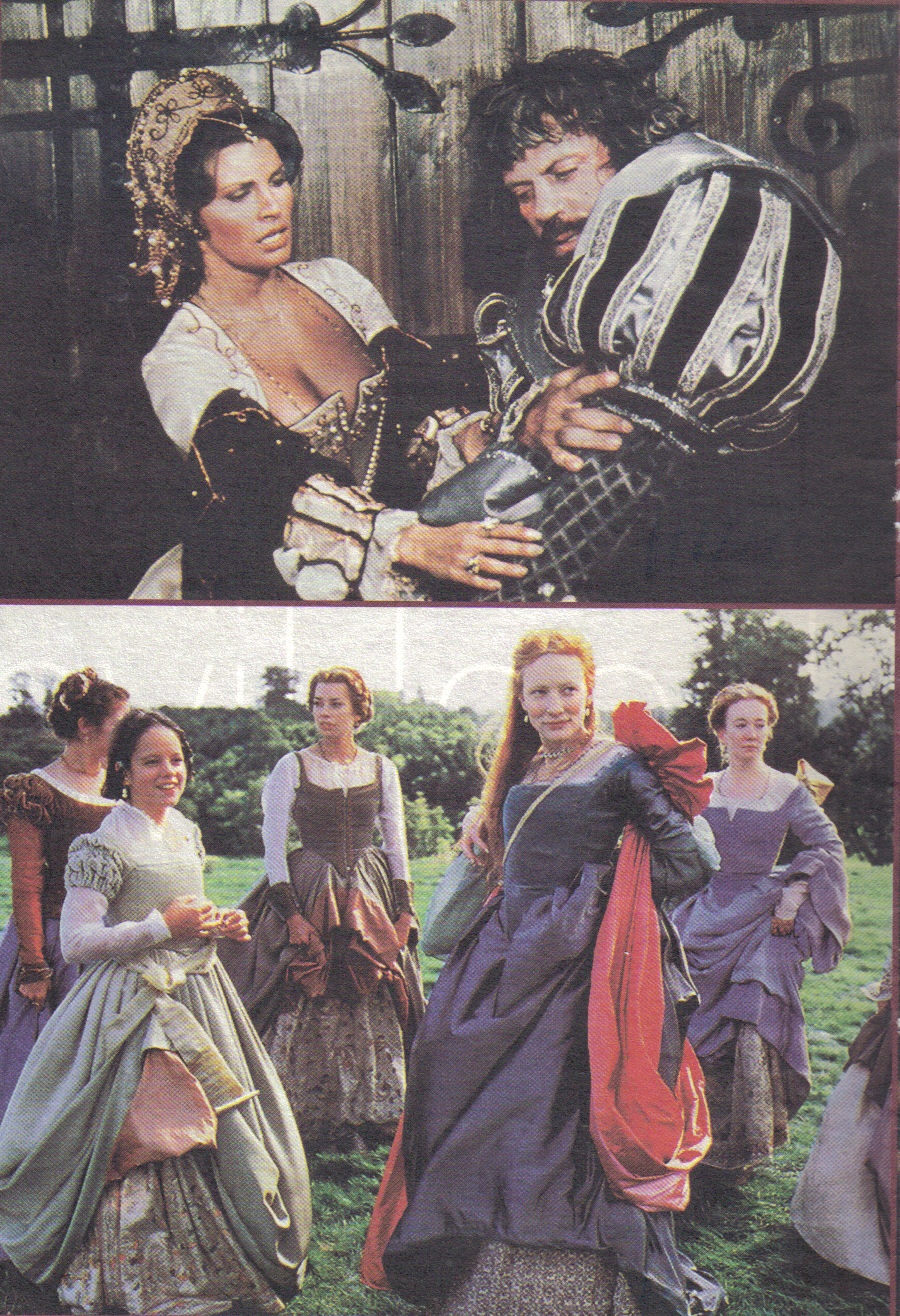
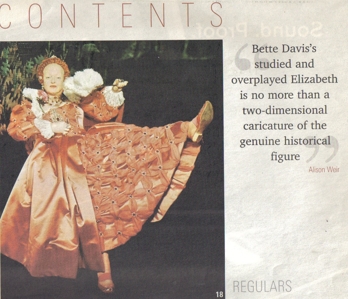
As someone who is passionate about the past, I am an avid viewer of historical films, and enjoy watching them on video again and again. As an historian, however, I am probably more aware than most people of the factual errors that are - sometimes deliberately - made by film-makers, whose brief is to reconcile historical accuracy with dramatic licence and produce a visual interpretation that is commercially viable.
As a writer who is constantly researching from contemporary sources, establishing facts and striving for historical accuracy, I am sometimes horrified at the liberties that are taken by film-makers. History, as they say, is stranger than fiction, and I see no need to embellish or alter it in the essentials, especially where the facts are well known. There is plenty of scope for invention where there are gaps in our historical knowledge or opportunities to interpret private relationships. Furthermore, I feel it is perfectly legitimate, in the interests of creating a good drama, to telescope events or create symbolic scenes.
Being something of an old reactionary, however, I tend to feel that historical films were sometimes done better in the past than they are now. There is no doubt that history is being dumbed down by television and film-makers, whose attitude to their audiences seemingly borders at times on the patronising or contemptuous. Only the other day, a BBC researcher spoke to me of using, in a historical programme, "language that a BBC1 audience can understand”. This is surely vastly underestimates viewers’ intelligence.
Any historical drama will automatically attract a well-educated audience with some knowledge of a subject in which they already have an interest. I know this from the attendances and questions at my talks on popular figures such as Henry VIII, Elizabeth I and Mary, Queen of Scots. And having talked to numerous readers, I know that they enjoy historical dramas. But there is little doubt that they are being sold short.
Many of the historical personages I have written about have been the subjects of films or TV drama series. Eleanor of Aquitaine
was one of the chief protagonists in the 1968 film, ‘The Lion in Winter’, starring Katharine Hepburn as Eleanor and Peter O'Toole as
Henry II, with a strong supporting cast. From 1173 to 1189, Henry kept Eleanor a prisoner after she rebelled against him with their sons, but in the 1180s she was allowed to join the court at Christmas and other festivals. In his intelligent screenplay, James Goldman imagines the interplay between the royal couple and their children during one Christmas at Chinon.
Katharine Hepburn's portrayal of Eleanor is masterful, as is Peter 0’Toole’s as Henry. This is essentially a film about relationships and power politics, with sharp, witty dialogue. I was saddened when a TV scriptwriter told me recently that "they wouldn't make it now".
O'Toole also played Henry II in an earlier film, ‘Becket’(1964), based on Jean Anouilh’s incisive stage comedy, opposite Richard Burton in the title role. Again, the script is clever and lively, with relationships and the conflicting issues of loyalty, morality and political expediency explored in depth in the compelling interaction between the main characters. Eleanor of Aquitaine makes a peripheral appearance in this film, but no attempt has been made to portray her as anything other than a shrewish queen who has no attraction for her husband. Glaringly, her costume is of the 15th rather than the 12th century. Nevertheless, these minor details should not detract from an otherwise excellent film.
A third portrayal of Eleanor was by Jane Lapotaire in the BBC TV series ‘The Devil’s Crown’ (1978), which starred Brian Cox as Henry II. The series depicted the reigns and relationships of the first three Plantagenets, and the tie-in book was written by an eminent historian, Richard Barber. A worthy attempt was made at historical accuracy; the script and acting were excellent, but some critics disliked the stagey sets and painted backdrops. Today, this splendid series is largely forgotten.
Apart from the BBC"s cycle of Shakespeare's plays, there have been few attempts to depict the Wars of the Roses on film, but Richard III was the subject of the definitive 1955 film based on the Bard's play. This film starred, and was adapted and directed by, Laurence Olivier, whose vivid portrayal of the King owed not so much to history as to a study in villainy. ‘Richard III’ was re-made in 1995 with lan McKellen in the title role; this time, the setting was not 15th century England, but an imaginary Fascist Britain of the 1930s, which worked very well, with the King being transformed into a dictator.
In my book The Princes in the Tower, I explored the histories of the pretenders who so troubled Henry VII by their claims to be scions of the House of York. An undeservedly forgotten BBC TV Series, ‘The Shadow of the Tower’ (1972), recounted their stories among other events of Henry VII"s reign, and starred the mesmeric James Maxwell as Henry. The series was soundly researched and well-scripted, with stunning costumes and convincing sets. It is a shame that it has not surfaced on video. [Note: this series is now available on DVD.]
Henry VIII and his wives have been the subjects of two of my books, and have often been portrayed on screen. The first major film about Henry VIII was Alexander Korda's ‘The Private Life of Henry VIII’ (1933), starring Charles Laughton. Laughton personified the popular perception of Henry as a bluff, gluttonous womaniser. The film begins with Anne Boleyn’s execution and ends with a comical portrayal of the ailing Henry suffering the nagging of a brisk Katherine Parr; in between, an inordinate amount of time is devoted to the love affair between an astonishingly mature-looking Katherine Howard and Thomas Culpeper.
The film was enormously influential, but it was Hollywood's interpretation of "Merrie England" and could be called the celluloid equivalent of a narrative painting of the romantic era, reflecting the preoccupations and fashions of its own time rather than the genuine realities of Tudor history. Laughton’s portrayal of the King is a mere caricature, but has been so powerful that it still influences popular perceptions of Henry today.
In 1953, in the Walt Disney film, ‘The Sword and the Rose’, Henry was again presented as a bluff, larger-than-life egotist, this time by James Robertson Justice. The film recounted – with hopeless inaccuracy - the love affair between Henry’s sister Mary (Glynis Johns) and Charles Brandon, and is best forgotten.
A much more serious portrayal of Henry VIII featured in Fred Zinnemann’s outstanding film about Sir Thomas More, the Oscar-winning ‘A Man for All Seasons’ (1966), which was based on Robert Bolt's very challenging stage play. Robert Shaw played a younger, slimmer Henry (early film-makers never took into account the fact that the King only became overweight in the last decade of his life), preoccupied with his need for a son and his conviction that his marriage to Katherine of Aragon was invalid. He is no caricature, but an attractive man whose every whim has hitherto been gratified, and who cannot now deal with any opposition to his views - a man whose finer self is at war with his baser needs.
Katherine of Aragon does not appear in the film, but Vanessa Redgrave makes a fleeting, unspeaking appearance as an incredibly authentic- looking and flirtatious Anne Boleyn.
Robert Shaw's role was disappointingly reprised in a 1988 television version of the film, starring Charlton Heston as Sir Thomas More. Heston himself played an ageing, and fairly convincing, Henry VIII in a cameo role in ‘The Prince and the Pauper’ (1977), based on Mark Twain"s novel and starring Mark Lester as a much-too-grown-up Edward VI.
The romantic view of Henry VIII was still evident in Charles Jarrott’s lavish film ‘Anne of the Thousand Days’ (1969), featuring Richard Burton as the King. Although visually stunning and shot in authentic locations (though often with dubious costumes), the film presented Hollywood"s distorted view of Tudor history, with (for example) Henry visiting Anne Boleyn when she was a prisoner in the Tower (in reality, the King never had any personal contact with those arrested for treason).
Disappointingly, Burton's acting was formulaic, as if he were playing a parody of his role and wished to distance himself from it. Genvieve Bujold had greater conviction as Anne Boleyn, but, given the fine supporting cast, this film could have been far better, given its good script, which derived from the stage play.
For me, the greatest and most accurate portrayal of Henry VIII was that by Keith Michell in the BBC TV series ‘The Six Wives of Henry VIII’ (six 90 minute plays, 1970), an outstanding production that was based on original source material and sound research, and - allowing for an acceptable degree of dramatic licence - achieved a high standard of authenticity that has never been surpassed.
An excellent spin-off film, ‘Henry VIII and his Six Wives’, followed in 1972, and again starred Keith Michell, but with different actresses playing the wives. Again, the production was remarkable for its historical accuracy. Keith Michell played Henry VIII one more time, in the BBC drama serial ‘The Prince and the Pauper’ (1997).
Later this year, there is to be a new Granada Drama TV series about Henry VIII, starring Ray Winstone and Helena Bonham-Carter. Henry and Anne and Mary Boleyn also feature in the television dramatisation of Philippa Gregory's novel, The Other Boleyn Girl.
Helena Bonham-Carter is no stranger to playing Tudor queens. In 1985 she starred in the title role in Trevor Nunn's film, Lady Jane, about the ill-fated nine-day Queen, Lady Jane Grey. Helena Bonham-Carter"s performance convinces, but the romantic portrayal of Jane’s relationship with her husband, Lord Guildford Dudley (Cary Elwes), is a travesty of historical truth. Otherwise, the film is sumptuously produced and well-acted.
Elizabeth I has been the subject of many films. Bette Davis’s was perhaps the most famous screen portrayal; she starred in ‘The Private Lives of Elizabeth and Essex’ (1939) with Errol Flynn, and ‘The Virgin Queen’ (1955). Both these films received the usual glamorous, anachronistic Hollywood treatment of English history, and Davis's studied and overplayed Elizabeth is merely a two-dimensional caricature of the historical figure.
I have to confess to not having seen Flora Robson's Elizabeth in ‘Fire Over England’ (1937), although I am aware that the film was dismissed as "swashbuckling nonsense" by one critic. The same could be said of ‘Young Bess’ (1953), starring Jean Simmons, who bore no resemblance at all to the youthful Elizabeth she portrayed.
Again, it was the BBC that produced the definitive Elizabeth, with Glenda Jackson"s brilliant and inspired performance in the 1971 TV series, ‘Elizabeth R.’ In my opinion, this has never been bettered. Like ‘The Six Wives of Henry VIII’, it was based on original source material and boosted by an excellent script, superb acting and authentic costumes.
The same could not be said for the film ‘Elizabeth’ (1998), starring Cate Blanchett. It contained so many factual errors that I could not list them all here. To give just a few examples: the Duke of Anjou who came courting the Queen was portrayed as a transvestite, when in fact it was his brother, Henry III of France, who dressed as a woman; the Duke of Norfolk was shown as a menacing, deadly threat to the throne, when in fact he was a dilatory and inept plotter; Durham Cathedral, with its dreadfully anachronistic Romanesque architecture, was used as Whitehall Palace; the plot against Elizabeth was a confused mish-mash of several conspiracies, and hardly any mention was made of their focal point, Mary, Queen of Scots. As one critic said, this was a film strictly for the MTV generation. Yet ‘Elizabeth’ was showered with awards – a Bafta and a Golden Globe for Blanchette’s central performance, and Oscar nominations for Best Picture, Best Actress and Costume Design.
Mary, Queen of Scots, the subject of my latest book, has yet to be realistically played on film. ‘Mary of Scotland’ (1936), starring Katharine Hepburn, is the usual Hollywood pastiche, with plenty of bagpipes whenever the Earl of Bothwell appears. ‘Mary, Queen of Scots’ (1971), though, features a sympathetic performance by Vanessa Redgrave as Mary, with Glenda Jackson reprising her role as Elizabeth I. The film shows the two Queens meeting - which never happened in real life - and deftly manages to avoid confronting any of the controversial issues surrounding Mary.
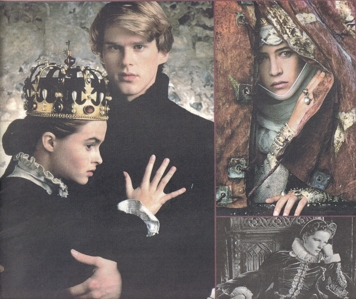
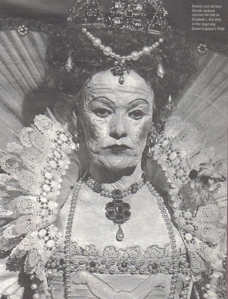
The book I am researching now is entitled Isabella, the She-Wolf of France, and is about the Princess who appears in the film "Braveheart", starring Mel Gibson and Sophie Marceau. This film has stunning, but highly inaccurate, battle scenes, and a poignant imaginary love story between the Scottish patriot, William Wallace, and Isabella, the wife of the future Edward II of England. On celluloid, such a love was inevitably doomed, for Isabella, although beautiful and spirited, was trapped in a loveless marriage to a homosexual, while Wallace would end up suffering the barbaric death meted out to traitors. The film ends, however, with a poetically just hint that the child Isabella was carrying, the future Edward III, was in fact fathered by Wallace.
It’s all very stirring stuff, but nothing could be further from the truth; in fact, on the basis of the film"s claims, this would have been the longest pregnancy in history. Wallace was executed in 1305, and Isabella did not come to England and marry Edward II until 1308; their eldest son, the future Edward III, was not born until 1312. So Isabella had nothing to do with Wallace. Thus are historical facts wantonly sacrificed in the interests of commercialism.
Personally, I would like to see a return to the time when film makers had more respect for history and for the intelligence of their audiences. History is now more popular than ever, but we need to distance ourselves from the modern received wisdom that it is better to have inaccurate history than no history at all. After all, history is fascinating and astonishing in its own right: you could not make it up, nor should you have to. It is unjustified arrogance and inverted elitism to think otherwise.
THE HOWARDS: THE RISE AND FALL OF A NOBLE FAMILY
by Alison Weir

The four Howard dukes of Norfolk, with Henry Howard, Earl of Surrey (second from right).
Everyone familiar with the history of Tudor England will have heard of the Howards, or the dukes of Norfolk, England's premier Catholic family. Katherine Howard was Henry VIII's fifth wife, while his second, Anne Boleyn, had a Howard mother. John Howard, first Duke of Norfolk, a descendant of Edward I, fell fighting for Richard III at the Battle of Bosworth in 1485. His son, Thomas, a soldier and statesman, had to fight his way back to royal favour under Henry VII and Henry VIII, and was not restored to the dukedom until shortly before his death in 1524.
His son, Thomas Howard, the 3rd Duke, was the Norfolk so renowned as Henry VIII's henchman. As Earl Marshal of England, he presided over most of the great events of the reign, including several state trials, and he was at the centre of many court intrigues. A blunt, ambitious and ruthless character, he cared for little but his own and his family's advancement. After the execution of his niece, Katherine Howard, in 1542, he and his family fell from favour. Further intriguing brought Norfolk to the Tower and a sentence of death, which he narrowly escaped because the King died before he could sign the warrant for the execution. Norfolk remained in the Tower during the six years of Edward's reign, but was released by Mary and, at the age of 80, helped her to put down Wyatt's rebellion.
Norfolk married twice, firstly to Anne of York, daughter of Edward IV; his second wife was Anne Stafford, who complained he ill-treated and abused her, preferring the company of his mistress, Elizabeth Holland.
Norfolk's son and heir was Henry Howard, Earl of Surrey, the renowned poet and courtier, who was brought up in the company of Henry VIII's bastard son, the Duke of Richmond. Suspected of treason, Surrey was sent to the Tower with his father in 1546, and was the last man to be beheaded in Henry VIII's reign.
His son, Thomas Howard, was later restored to the dukedom of Norfolk and married three times. During the reign of Elizabeth I, he foolishly intrigued to marry the captive Mary, Queen of Scots, with a view to setting Mary on the English throne with himself as her consort. The plot was discovered and Norfolk went to the block in 1572.
Thereafter, the fortunes of the Howard family diminished, as they identified themselves with the Catholic cause, which was tantamount to treason at that time. Norfolk's son, Philip, spent most of his life in the Tower for his faith, died there, and was later made a saint. Only towards the end of Queen Elizabeth's reign did the Howard fortunes begin to revive, but the family never regained its former prominence.
Writtem for London History magazine, 2002 (this magazine was never published):
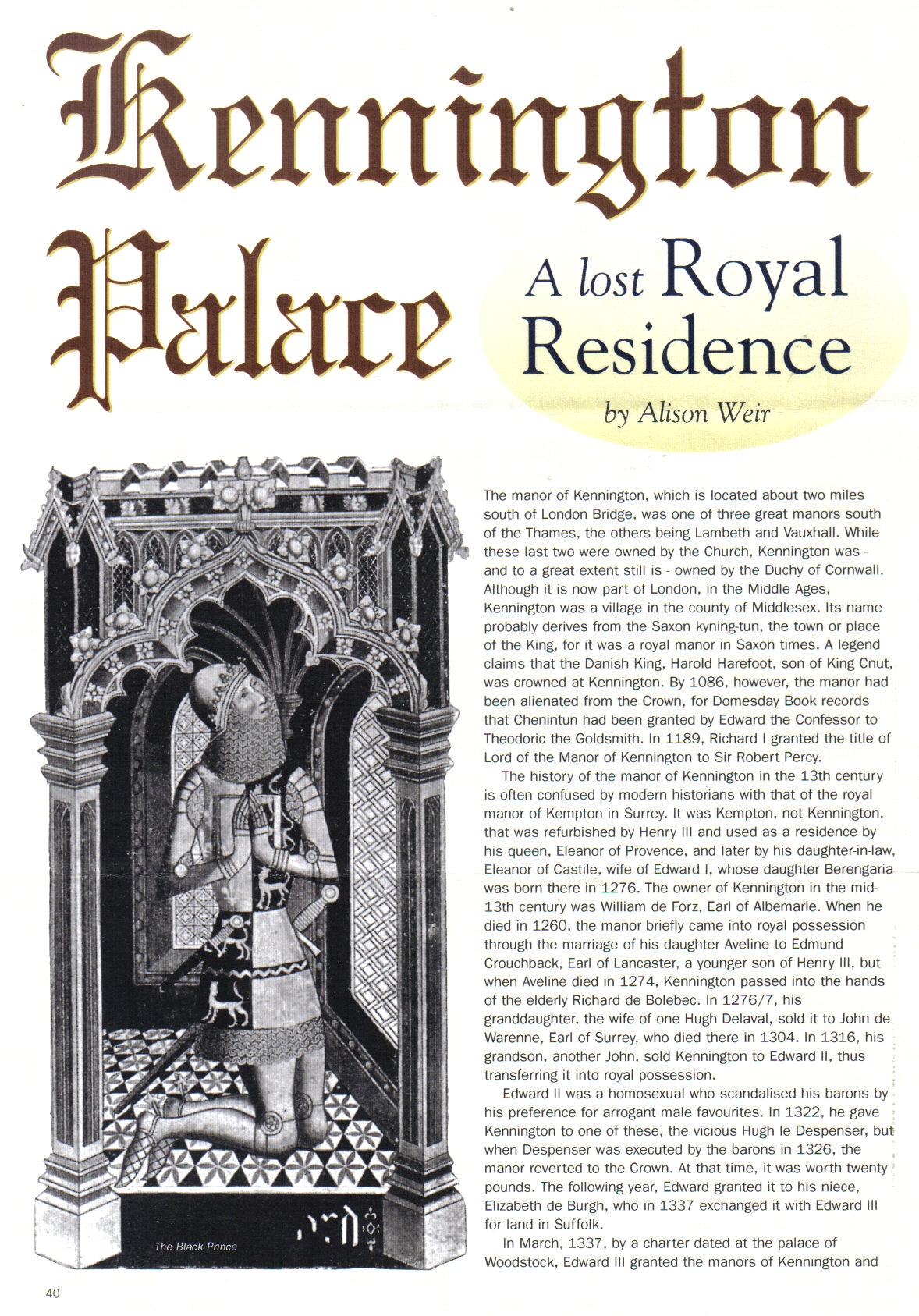
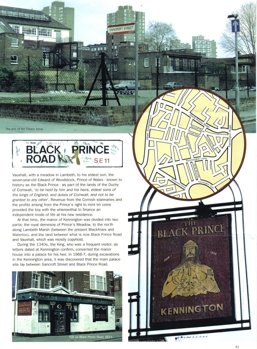

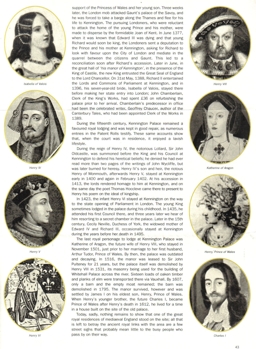
The manor of Kennington, which is located about two miles south of London Bridge, was one of three great manors south of the Thames, the others being Lambeth and Vauxhall. While these last two were owned by the Church, Kennington was - and to a great extent still is - owned by the Duchy of Cornwall. Although it is now part of London, in the Middle Ages Kennington was a village in the county of Middlesex. Its name probably derives from the Saxon kyning-tun, the town or place of the King, for it was a royal manor in Saxon times. A legend claims that the Danish King, Harold Harefoot, son of King Cnut, was crowned at Kennington. By 1086, however, the manor had been alienated from the Crown, for Domesday Book records that 'Chenintun' had been granted by Edward the Confessor to Theodoric the Goldsmith. In 1189 Richard I granted the title of Lord of the Manor of Kennington to Sir Robert Percy.
The history of the manor of Kennington in the 13th century is often confused by modern historians with that of the royal manor of Kempton in Surrey. It was Kempton, not Kennington, that was refurbished by Henry III and used as a residence by his queen, Eleanor of Provence, and later by his daughter-in-law, Eleanor of Castile, wife of Edward I, whose daughter Berengaria was born there in 1276. The owner of Kennington in the mid-13th century was William de Forz, Earl of Albemarle. When he died in 1260, the manor briefly came into royal possession through the marriage of his daughter Aveline to Edmund Crouchback, Earl of Lancaster, a younger son of Henry III, but when Aveline died in 1274, Kennington passed into the hands of the elderly Richard de Bolebec. In 1276/7 his granddaughter, the wife of one Hugh Delaval, sold it to John de Warenne, Earl of Surrey, who died there in 1304. In 1316 his grandson, another John, sold Kennington to Edward II, thus transferring it into royal possession. Edward II scandalised his barons by his preference for arrogant male favourites. In 1322 he gave Kennington to one of them, the vicious Hugh le Despenser, but when Despenser was executed on the orders of Edward's disaffected Queen, Isabella of France, in 1326, the manor reverted to the Crown. At that time it was worth twenty pounds. The following year, Edward granted it to his niece, Elizabeth de Burgh, who in 1337 exchanged it with Edward III for land in Suffolk.
In March, 1337, by a charter dated at the palace of Woodstock, Edward III granted the manors of Kennington and Vauxhall, with a meadow in Lambeth, to his eldest son, the seven-year-old Edward of Woodstock, Prince of Wales - known to history as the Black Prince - as part of the lands of the Duchy of Cornwall, 'to be held by him and his heirs, eldest sons of the kings of England, and dukes of Cornwall, and not to be granted to any other'. Revenue from the Cornish stannaries and the profits arising from the Prince's right to mint tin coins provided the boy with the wherewithal to finance an independent mode of life at his new residence.
At that time, the manor of Kennington was divided into two parts: the royal demesne of Prince's Meadow, to the north along Lambeth Marsh (between the present Blackfriars and Waterloo), and the land between what is now Black Prince Road and Vauxhall, which was mostly copyhold.
During the 1340s, the King, who was a frequent visitor (as letters dated at Kennington confirm), converted the manor house into a palace for his heir. In 1966-7, during excavations in the Kennington area, it was discovered that the main palace site lay between Bancroft Street and Black Prince Road. The palace comprised a number of separate buildings in series, the great hall being at the centre. The excavation uncovered its undercroft, with evidence that both hall and undercroft had vaulted ceilings supported by two rows of pillars; the height of the undercroft has been calculated at eight and a half feet. Adjoining the hall to the north-west was the smaller Prince's Chamber, with the privy or 'high chamber' above, next to which was a 'little chapel'. The Queen's chamber stood apart, but in line with the other buildings and surrounded by the privy garden. To the south of the great hall were buildings housing the service complex, including the kitchen, the larder and the saucery. At the south-east end of the site, built at right angles to the hall, was a long stable block.
The palace gardens, which in 1390 were described as being rich with vines, extended as far as the present East Stand of the Oval Cricket Ground, which itself is still part of the Duchy of Cornwall Estate. A little way to the north lay Lambeth Palace, the London residence of the Archbishops of Canterbury. The vine garden survived at least until 1461, and was perhaps located in the Prince's Meadow; in the early 14th century Hugh le Despenser had sent wine made at Kennington to the London markets.
The Black Prince lodged at Kennington whenever his presence was required in London, and made many improvements to the palace. In the Register of the Black Prince there exists an order to his receiver general 'to pay the Prince's clerk, Sir Richard de Rotheley, whom the Prince has appointed controller of his masonry works at his manor of Kennington, the fourpence halfpenny a day granted him until the works be completed, in addition to the sevenpence halfpenny granted him for his wages, provided that he find a clerk to enrol and enter the particulars of the works'. These works included masonry, carpentry and 'ironwork ... for the hall and the Prince's chambers there'.
Evidently the work was not carried out to the Prince's satisfaction, for throughout the 1350s there were further extensions, improvements and repairs. These included the building of a new hall, designed by the renowned master mason, Henry Yevele. This hall, which was five years in the building, measured 90' by 50'; it was faced with Reigate stone, had three fireplaces and a tiled roof, and was adorned with statues. The floor was probably laid with glazed tiles decorated with the Prince's arms. When the Black Prince was in residence, the walls were probably hung with the sets of tapestries that he is known to have owned. The Prince also ordered the storehouses in the vaults of the hall to be searched, cleared and 'filled with earth or turf and rubble, in such a way as shall best tend to the preservation of the vaults'.
In 1362, the Black Prince spent the summer at Kennington with his new bride, Joan of Kent. That same year, he granted the manor of Vauxhall to the Prior and Convent of Christ Church, Canterbury, and from that time onwards the two manors remained under separate ownership.
Although he spent long periods at Kennington during his last illness, it was at Westminster Palace that the Black Prince died in 1376, having been too weak to make one final journey to Kennington. His widow, Joan of Kent, and their surviving son, the future Richard II, were staying at the palace when the Prince passed away, and continued to reside there until Richard's accession in June 1377. Richard spent much of his childhood there. By the time he was ten years old, his grandfather Edward III was in his dotage, and much of the burden of government fell on the King's eldest surviving son, John of Gaunt, Duke of Lancaster. Gaunt was unpopular with the Londoners, who unjustly held him responsible for heavy taxation, and on 1 February, 1377 they marched in a torchlit procession to Kennington to protest about this and secure the support of the Princess of Wales and her young son. Three weeks later, the London mob attacked Gaunt's palace of the Savoy, and he was forced to take a barge along the Thames and flee for his life to Kennington. The pursuing Londoners, who were reluctant to attack the home of the young Prince and his mother, were made to disperse by the formidable Joan of Kent.
In June 1377, when it was known that Edward III was dying and that young Richard would soon be king, the Londoners sent a deputation to the Prince and his mother at Kennington, asking for Richard to look with favour upon the City of London and mediate in the quarrel between the citizens and Gaunt. This led to a reconciliation soon after Richard's accession. Later in June in the great hall of 'his manor of Kennington', in the presence of the King of Castile, the new King entrusted the Great Seal of England to the Lord Chancellor. On 31 May 1388 Richard II entertained the Lords and Commons of Parliament at Kennington, and in 1396 his seven-year-old bride, Isabella of Valois, stayed there before making her state entry into London; John Chamberlain, Clerk of the King's Works, had spent £36 on refurbishing the palace prior to her arrival. Chamberlain's predecessor in office had been the celebrated writer, Geoffrey Chaucer, author of the 'Canterbury Tales', who had been appointed Clerk of the Works in 1389.
During the fifteenth century Kennington Palace remained a favoured royal lodging and was kept in good repair, as numerous entries in the Patent Rolls testify. These same accounts show that when the court was in residence it enjoyed a lavish lifestyle.
In the reign of Henry IV, the notorious Lollard, Sir John Oldcastle, was summoned before the King and his Council at Kennington to defend his heretical beliefs; he denied he had ever read more than two pages of the controversial writings of John Wycliffe, but was later burned for heresy. Henry IV's son and heir, the riotous Henry of Monmouth, afterwards Henry V, stayed at Kennington early in 1400 and again in February 1402. At his accession in 1413, the lords rendered homage to him at Kennington, and on the same day the poet Thomas Hoccleve came there to present to Henry his poem on the ideal of kingship.
In 1423 the infant Henry VI stayed at Kennington on the way to the state opening of Parliament in London. The young King sometimes lodged in the palace during his childhood. In 1435 he attended his first Council there, and three years later we hear of him resorting to a secret chamber in the palace. Later in the 15th century, Cecily Neville, Duchess of York, the widowed mother of Edward IV and Richard III, occasionally stayed at Kennington during the years before her death in 1495.
The last royal personage to lodge at Kennington Palace was Katherine of Aragon, the future wife of Henry VIII, who stayed in November 1501, just prior to her marriage to her first husband, Arthur Tudor, Prince of Wales. By then, the palace was outdated and decaying. In 1516 the manor was leased to Sir John Pulteney for 21 years, but the palace itself was demolished by Henry VIII in 1531, its masonry being used for the building of Whitehall Palace across the river. Sixteen loads of oaken timber and planks of elm were transported there via Vauxhall. By 1607 only a barn and the empty moat remained; the barn was demolished in 1795. The manor survived, however and was settled by James I on his eldest son, Henry, Prince of Wales. When Henry's younger brother, the future Charles I, became Prince of Wales after Henry's death in 1612, he lived for a time in a house built on the site of the old palace.
Today, sadly, nothing remains to show that one of the great royal residences of medieval England stood on the site; all that is left to betray the ancient royal links with the area are a few street signs that probably mean little to the busy people who pass by on their way.
MONASTICISM IN ENGLAND
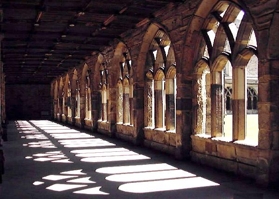
My specialist subject at A-Level was ‘Twelfth-Century Monasticism in the West’. This is a talk written for one of English Heritage’s Tours Through Times, on which I was guest historian.
In our modern, secular world, we are often unaware of how large a part religion once plates in people’s lives. Hundreds of years ago, England was populated with numerous abbeys and priories in which countless people lived lives of prayer, often secluded from the world.
The earliest monastic Order was that of the Benedictines, founded by St Benedict in the early 6th century. By the time of his death in AD 543, he had founded fourteen houses of men and women whose lives were devoted to the service of God. St Benedict wrote the earliest monastic rule, declaring: "In living our life, the path of God's commandments is run with unspeakable loving sweetness: so that, never leaving His school, but persevering in the monastery until death in his teaching, we share by our patience the sufferings of Christ, and so merit to be partakers of His kingdom."
The aim of the rule was for each individual to attain a state of sanctity that was compatible with living in a community and the performance of the divine offices in choir.
Throughout the Dark Ages and the early medieval period, the Order spread, and it became influential in the fields of art, literature and education. The Benedictines were first introduced into England bv St Augustine in the 6th century. By the time of the Dissolution of the Monasteries in the 1530s, there were about 300 Benedictine houses in England, including all the cathedral priories and most of the richest abbeys. The universities of Oxford and Cambridge owe their origins to the monastic foundations of the Benedictines.
Benedictine monks and nuns were required to take vows of chastity, poverty and obedience. Their lives revolved around the ‘opus manus’ (the work of the hands) and the ‘opus Dei’, the work of God (prayers and intercessions). The daily lives of the religious were punctuated by the canonical hours, the services that were held in the conventual church: Prime at 6 am, Terce at 9 am, Sext at noon, None at mid-afternoon. Vespers around 4 pm, Compline at 7 pm, and Matins and Lauds at midnight or daybreak.
Breakfast would be at 6.30am, followed by work or reading. There would be a meeting of the community in the chapter house in the morning, followed by High Mass, then dinner. In the early afternoon, the monks had rest and recreation, followed by work, and supper at 6.30pm. They would retire to bed after Compline.
They slept in their habits in communal dormitories divided into cubicles, each with a writing desk. Bedding consisted of a mat or straw pallet, a woollen covering and a pillow. There was usually a stairway from the dormitory to the church to enable the monks easy access for the night hours.
Most religious houses were built to a similar plan. The principal building was the church, as large and splendid as the community could afford. It was built in a cruciform shape. The domestic buildings were normally erected around a cloister, a galleried quadrangle where the monks could take exercise or work in fine weather. In the centre of the cloister was a square, grassy garth, which served as a burial ground for the community. The chapter house was usually adjacent to the church, while the infirmary and guest house were usually located a little way away from the main complex. The refectory and kitchens normally adjoined the cloister, and there was usually a warming room, where a fire was kept burning in winter; the monks were allowed spend an hour or so each day there.
Monasteries were usually built near rivers or streams to ensure an adequate supply of fresh water and fish.
The abbey precincts of Benedictine monasteries provided all kinds of social services. Their infirmaries treated the sick; their schools offered education for all classes; their guest houses sheltered travellers; they dispensed charity to the poor, and offered employment to the laity; they were often the refuge of undowered girls from good families.
By the 12th century, however, the Benedictine Order had become lax and was falling into disrepute. This was the great age of monasticism, and it gave birth to other Orders that were founded as a reaction to the Benedictine decline.
In 1068 King William the Conqueror marched from the south with all his levies and ravaged York, slaying many hundreds. The north was devastated, and it would take decades for it to recover – and that was largely thanks to the Cistercians.
This was a religious Order for men and women, founded at Citeaux, near Dijon, in 1098, by Robert of Champagne, a Benedictine abbot; it was noted for the rigidity and uniformity of its rule, which was the strictest interpretation of the rule of St Benedict. The Latin name for Citeaux was Cistercium, hence the name Cistercians. The Order was distinguished by its white habits.
The 12th century was the golden age of the Order, when its fame was closely allied to that of St Bernard of Clairvaux, who founded the Cistercian monastery of Clairvaux and was extremely active in encouraging the foundation of further houses. When he died in 1153, the Order had 338 abbeys throughout Europe.
The architectural achievements of the Cistercians at this time were considerable. Many houses reflected Bernard's preference for simple lines in keeping with the gravity and simplicity of the Order. Cistercian abbeys were therefore markedly similar in appearance.

Rievaulx Abbey in Yorkshire was founded during St Bernard’s lifetime. In 1131 the land on which it was to stand was still a wilderness. That year it was granted by Walter 1'Espec to a band of twelve Cistercian monks, who founded the first Cistercian abbey in England. Thus began an exceptionally prosperous House. The ruins that remain were mostly built in the 12th century.
Between 1147 and 1167, under the third Abbot, St Aelred, there were 140 monks and more than five hundred lay brothers. The Cistercians were responsible for restoring prosperity to the ravaged area, principally through sheep farming.
In 1322 Edward II stayed at Rievaulx, but was caught unprepared, and nearly captured by, the raiding Scots, who sacked the abbey after he had fled to York.
By the fifteenth century, the abbey had become too large, and parts of the chapter house, warming house and dormitory were taken down. By now the Cistercians – like the Benedictines before them – had earned a reputation for laxness and greed. As their riches grew, their austerity of life dwindled.
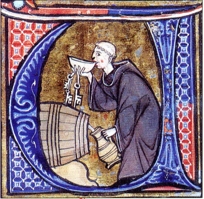
By 1539, the year Rievaulx was dissolved, there were only twenty-two monks. The abbey was left to decay. There were over a hundred Cistercian houses in England, but after the Reformation, the Cistercians disappeared from northern Europe.
The Carthusians were an order of monks founded by St Bruno in 1084 at Grande Chartreuse near Grenoble, France. The chief characteristics of the Order were separate dwelling houses for each monk and a general assembly in church twice each day and once at night. The monks wore rude habits consisting of a haircloth shirt, a white cassock and a black cloak; they ate a most frugal diet, often consisting of raw vegetables and coarse bread. Each cell was furnished with a straw bed, pillow, coverlet and writing materials. Each brother lived in isolation, and never left his cell except for services, celebrations or the funeral of a fellow monk
The Order invented, and still holds the secret of, the liqueur, Chartreuse.
In England, where the Order was first established in 1180, Carthusian monasteries were often known as Charterhouses. The London Charterhouse was founded in 1371.
In the 1530s a Carthusian prior, John Houghton, and many of his monks opposed Henry VIII"s royal supremacy; for this, they died a terrible death.
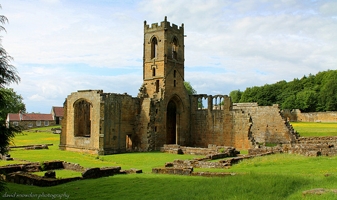

Mount Grace Priory is England's finest example of a Carthusian monastery. It was established in 1398 by Thomas Holland, Duke of Surrey (a half-brother of Richard II), for twenty monks who, according to their strict rule, lived in separate cells; it was last monastery established in Yorkshire.
After Richard was deposed in 1399, Holland lost his dukedom, and the monastery had much trouble holding on to its endowments. Holland rebelled against the new King, Henry IV, and was beheaded. He was buried here.
At the Dissolution, the last prior, John Wilson, was granted the Lady Chapel - still in use - and a dwelling house on the steep bank above the priory. In 1654 the owner of the ruins, Thomas Lascelles, converted the buildings to the left of the gate into a private residence, which is still lived in.
The remains at Mount Grace give a vivid picture of a Carthusian House and its rule.
A contemplative Order founded as a reaction against the laxity of many monasteries., its monks lived as hermits within their communities. At Mount Grace each had a house, or cell, measuring 27" square, consisting of a living room, bedroom, study and lobby on the ground floor with a workshop above. Each house opened onto a walled garden, with a lavatory – necessarium – at the bottom of it. There was a hatch in the front wall through which food was passed. The monks ate together only on Saturdays. The cells surrounded a large cloister and the small, plain church. One cell has been restored. The cookhouse, granaries, guest house and stables were built on an outer courtyard.
Throughout the 15th century, monasticism was in decline in England. No new Orders were founded apart from that of the Bridgettines, named after their foundress, St Bridget of Sweden. A house of this Order was founded in 1415 at Syon in Middlesex by Henry V. But it was Henry V who also began closing down monasteries that had ceased to be viable. A century later, under Henry VIII, Cardinal Wolsey was doing the same thing, having obtained the permission of the Pope to dissolve some of the lesser houses.
Then came Henry VIII's break with Rome and the Reformation. The King and his chief minister, Thomas Cromwell, regarded the monasteries as potential hotbeds of resistance and papistry. Henry was eager to get his hands on their wealth, their treasures and their lands. He wanted to be able to offer material rewards to those who had supported him in his religious revolution.
In 1535, under the auspices of Thomas Cromwell, a survey was made of the state of all the religious houses in England; it was known as the ‘Valor Eccleciasticus’. Clearly many monasteries were functioning properly, but there were some in which corruption, laxity and debauchery were rife, and Cromwell capitalised on this. "Manifest sin, vicious, carnal and abominable living is daily used and committed amongst the little and small abbeys," his report read. Consequently, between 1536 and 1540, every monastery and convent in England was dissolved. The monks and nuns were pensioned off; some went to religious houses abroad, others were absorbed back into secular society. A few abbots and priors resisted the King's commissioners, and were hanged for their pains.
The deserted monastic buildings were stripped of their treasures, the lead from their roofs and, in many cases, their stones, which were taken away by local people to build houses. The King's coffers grew ever fuller; he took to wearing on his thumb the great ruby that had adorned the shrine of Thomas Becket at Canterbury.
Monastic churches became cathedrals or parish churches. Some abbeys were granted or sold off to loyal courtiers and converted into lavish country houses. Others fell into decay. In many cases, the valuable contents of monastic libraries were lost.
But the greatest loss was felt in human terms. Secular schools, inns and hospitals could to a degree provide the services that the monks had once provided, but there was no provision for the army of vagrants that the religious houses had succoured, whose ranks the dispossessed religious now swelled. By the end of the 16th century, the problem of vagrancy had become so acute that Parliament passed the Poor Law Acts, which established parish relief and the workhouse system, a system that was to blight the lives of the poor for over three centuries.
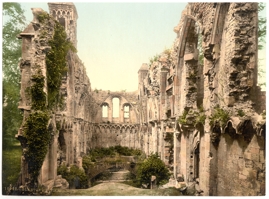
After the 1530s England was no longer the 'ringing isle', as she had been known in the middle ages, thanks to the constant chiming of church bells. The landscape and social structure of the realm had been changed forever.By Elizabeth's reign, many of the monasteries were in ruins, as they remain today, and as this poem on the decaying abbey of Our Lady of Walsingham describes:
'Level, level with the ground
The towers do lie.
Which, with their golden, glittering tops
Pierced once to the sky!
Where were gates, no gates are now;
The ways unknown
Where the press of peers did pass.
While her fame far was blown.
Owls do shriek where the sweetest hymns
Lately were sung;
Toads and serpents hold their dens
Where the palmers did throng.'
READ ABOUT ALISON WEIR'S DESERT ISLAND BOOKS HERE:
http://www.welovethisbook.com/features/alison-weirs-desert-island-books
SAVE NORTHAMPTON CASTLE!
I was pleased to support the Friends of Northampton Castle, who are dedicated to ensuring that the importance of Northampton’s medieval heritage is recognised and celebrated.
Visitors arriving in Northampton today may be forgiven if they do not realise that the town ever had a castle. There is very little of it that remains to be seen. We hear too often that the castle has been lost, that nothing remains. In fact there is a great deal of it left underground, which could be explored and restored. Northampton Castle was of major historical importance as a seat of Parliament and the fourth biggest castle in the country in its time. but does that mean it should be forgotten?
Erected by Simon De Senlis in 1084, the castle was located on the site of Northampton Station, where the postern gate is still visible. It became an important seat of power, playing host to kings. Parliaments were held there and the castle was the setting for the famous trial of Archbishop Thomas Becket, who was later murdered in 1170. In 1205, King John is known to have moved the royal treasury to the castle, and in 1460 Henry VI stayed there before the Battle of Northampton. The castle met its literal downfall in 1662 when, resenting Northampton’s parliamentary support, the restored monarch Charles II ordered the building’s defences to be destroyed, so that it could not again be used as a castle. Thereafter it was used as a court and a gaol but, as the years went by, it fell into decay. In 1861 the land was finally sold to L. & N.W. Railway and the majority of the castle’s remains were demolished in 1870 to facilitate the building of the station.
Excavations were carried out in the 1960s, and experts now believe that the site could still hold some interesting archaeological finds, with the potential to reveal more about the castle’s past. FONC aims to bring new life to this great period in our local and national history. To find out more or to get involved visit: www.northamptoncastle.com
26 TREASURES
Across Scotland and beyond, 26 writers have been exploring ways of bringing treasures from the National Museum of Scotland to life in words. At the Winter Words Festival at the Pitlochry Festival Theatre in February 2012, a panel of contributing writers, including Linda Cracknell, Jamie Jauncey and (guesting) Alison Weir will discuss how tapping into the rich story of Scotland’s past through objects can connect them not only to social, political, cultural and religious history, but to the powerful emotions of people who lived at the time. Each of the 26 writers had contributed a piece of creative writing (not exceeding 62 words long) in response to the treasure assigned them. Being a guest contributor, Alison was allowed to choose her treasure, and opted for the Leisian gneiss, a rock hundreds of millions of years old. It inspired her to write the following poem, an abbreviated version of which she recited at the Festival.

GOD'S THEATRE: THE HIGHLANDS OF SCOTLAND
Here in God's theatre
Nature has writ in marvellous words
in one ceaseless brave scenario
the play of the ages,
and with a crooked finger carved the lines
so long ago, in acts too changing for men to stop
and think and listen. For
the hills unit in silent chorus,
the lochs reflect unspoken odes,
primeval echoes down the centuries,
the unsung exit of the last volcano.
And we, the watchers,
do we yet applaud this great performance,
never so divine
as when each new eye doth see it?
Do we gaze in wonder,
dazzled by the vastness of this celestial amphitheatre,
the aweful magnificence of Heaven's scripting, Nature's cast?
Do we tremble, knowing that when we are long gone,
the words, the play, the song -
they still will last?
For more information, go to www.26treasures.com.
LUCREZIA BORGIA
Original book proposal by Alison Weir
(This book was commissioned in 2001, but never written, because Sarah Bradford, an expert on the Borgias, published an excellent biography, and Alison chose to write about Katherine Swynford instead.)
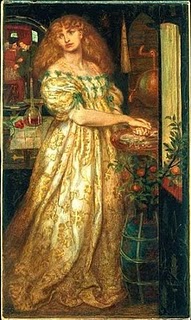

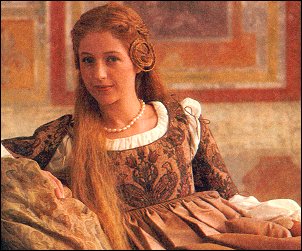
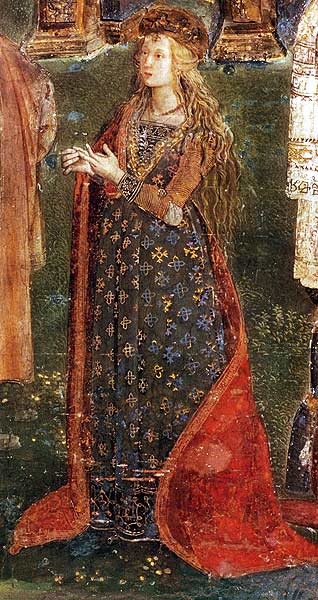
Say the name Lucrezia Borgia, and it conjures up images of sex, orgies, incest and murder. During the five centuries since her death, Lucrezia Borgia has become a byword for feminine infamy, immortalised in the works of Niccolo Machiavelli, Johannes Burchard, Alexander Dumas, Victor Hugo and Guillaume Apollinaire. Yet although her life was touched by notoriety and scandal, when she died in 1519, she was lauded for her piety and gentleness. Hence, she is an enigma: who was the real Lucrezia Borgia?


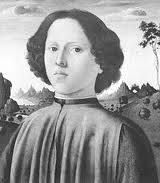
Lucrezia was born in 1480 in Rome, one of four bastard children born to Cardinal Roderigo Borgia by his Roman mistress Vanozza Catanei. Her three brothers (above) were Giovanni (Juan), Duke of Gandia, the brilliant but infamous Cesare Borgia (born 1475), whose brooding good looks, magnetic charm and ruthless ambition made him one of the most feared and villified public figures of his day; and Goffredo (Joffre), Prince of Squillace. In fact, the corrupt, avaricious and nepotistic Borgias would bring the Vatican into such disrepute that, not only did their name become synonymous with wickedness, but the reputation of the papacy was irrevocably tarnished, which was one of the chief causes of the Reformation.
The Borgias were of Spanish origin (the name was originally Borja or Borya), but moved to Italy in the 15th century when one of their number became Pope Calixtus III in 1455. Roderigo Borgia was his nephew. In 1492, when Lucrezia was 12, her father in turn became Pope, as Alexander VI (below), and it was only now that he publicly acknowledged his illegitimate children by Vanozza. His ambition was such that he desired to match Lucrezia only with the greatest of Princes; before she was 11, he had already turned down two suitors as being not grand enough for her.
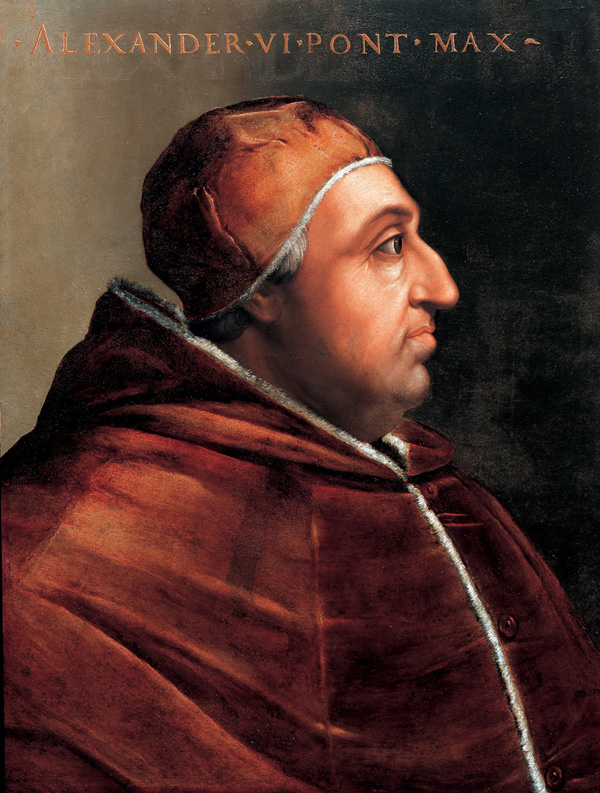

Now, he placed her in the care of his celebrated new mistress, Giulia Farnese, and her mother-in-law, Adriana di Mila, who lived with Lucrezia in the magnificent Palazzo di Santa Maria and prepared her for the duties of matrimony. At 13, Lucrezia was ripe for the marriage market, graceful, golden-haired and slender, with teeth like pearls, and her father offered her hand to Giovanni Sforza, the handsome young Lord of Pesaro (below). Sforza eagerly accepted, and the cream of Roman society attended the wedding, which took place in 1493 - not without censure, however, since it was celebrated with a play by Plautus featuring libertines, prostitutes and pimps. Lucrezia was nevertheless apparently delighted with her new husband.

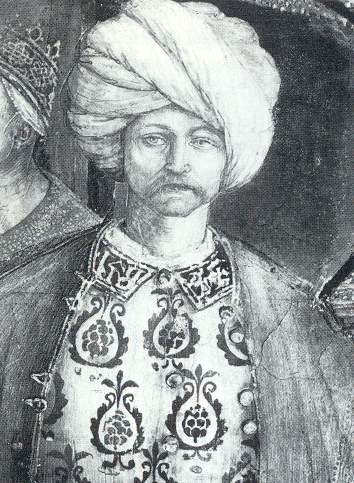
But after four years, the Pope and his sons realised that they could have made a more advantageous match for her with the influential House of Aragon, who ruled Sicily and Naples. Sforza was now an inconvenience who would have to be disposed of, and it was presently announced to the world that he had been unable to consummate his marriage to Lucrezia because he was impotent.
Outraged and humiliated, Sforza protested that he was a normal man who had 'known his wife carnally on countless occasions'. When it was suggested that he prove it in front of members of the Borgia and Sforza families, he indignantly refused. But he could not withstand the power of the Borgias, who had Lucrezia examined and declared virgin by a panel of matrons, compelled her luckless husband to sign an admission of his impotence, and annulled the marriage. Sforza very prudently fled from Rome, lucky to escape with his life.

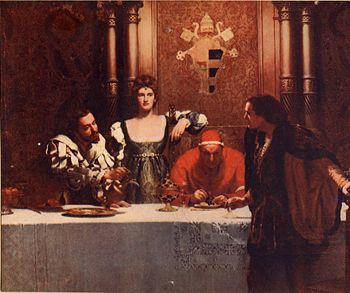
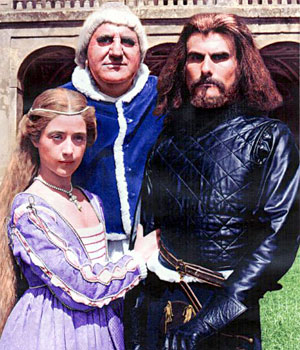
Lucrezia had long since become bored with her husband, but she was utterly dominated by her father and her brother Cesare. She agreed without protest to the dissolution of her marriage. It was essential that the pretence of virginity be maintained, so she was sent to the convent of San Sisto on the Appian Way to prepare for a second marriage. When the time came for her to leave, the nuns were sorry to lose her because they would miss the sophisticated and worldly pleasures to which she had introduced them.
It soon became apparent that Lucrezia was pregnant, and certainly not by her husband. Rumour had it that she had taken a lover, a Spaniard who had conveyed letters between the Pope and his daughter whilst she was at the convent. His name was Pedro Calderon, but he was commonly called Perotto. There is no doubt of his charisma or his desire for Lucrezia. Yet her jealous brother Cesare first attacked him in the Pope's presence, then had him thrown into prison for presuming too far with his sister; six days later his body was found in the River Tiber, along with that of Lucrezia' s maid, who was thought to have acted as a go-between for the lovers.
The affair gave rise to sensational rumours. It was said that Cesare Borgia was the father of his sister's coming child. Certainly his love for Lucrezia was abnormally intense for a brother, and probably incestuous, although there is no evidence that it was reciprocated. The rumours were fuelled by Giovanni Sforza, who, anxious to take revenge on the men who had robbed him of his bride, put it about that Lucrezia was the mistress, not only of both her brothers, Cesare and Giovanni, Duke of Gandia, but also of her father, the Pope, who was then 67 years old.
On balance, it appears that the father of the child Giovanni (later Duke of Nepi ) , who was born in Rome in 1498, was Calderon, but Lucrezia would never even admit to being his mother, let alone disclose who had sired him. Although she kept the boy with her, she always referred to him as her brother. Publicly, he was referred to as 'the Roman Infante'. Three years after his birth, the Pope officially declared that Giovanni was the son of Cesare by an unknown woman, but soon he followed this with a declaration that the boy was in fact his own son, again by an unknown woman. It was claimed at the time that Lucrezia herself had requested the Pope to make these announcements as she herself did not know which of them, her father or her brother, had sired her child.

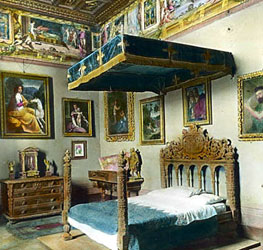
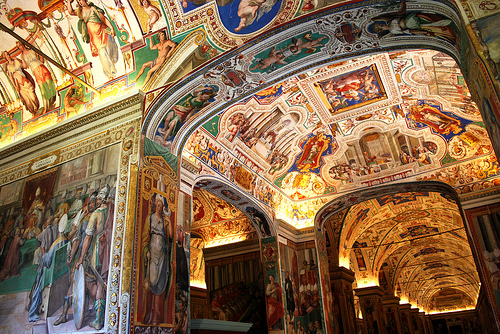
(Above: the sumptuous Borgia apartments in the Vatican)
Later in 1498, despite the scandal, the Borgias achieved their ambition and married Lucrezia to the King of Naples' nephew, Alfonso of Aragon, Duke of Bisceglie. The bridegroom was 17, fair-haired and dazzlingly handsome, and an entranced Lucrezia fell in love with him almost instantly. Cesare welcomed him to the family in the friendliest manner, and the Pope spared no expense in giving the young couple a splendid wedding. In return, Alfonso promised the doting father to stay with Lucrezia in Rome for a year before taking her south to his estates. There was one son of the marriage, called Roderigo after his grandfather.
Before long, however, Cesare's jealousy once more manifested itself, and to such an extent that prayers were being said in Rome for the safety of the Duke of Bisceglie. In vain, for one night, after leaving the Vatican, he was set upon by assassins in St Peter's Piazza. Fortunately, his friends came to his rescue and carried him home, half-dead, to the Palazzo di Stota Maria; his skull had been split open, and he had suffered dreadful wounds to his legs and body. A shocked Lucrezia nearly fainted when she saw him, but rallied to the occasion and nursed him devotedly back to health. She was well aware of whom it was that had ordered his murder.
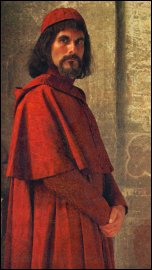
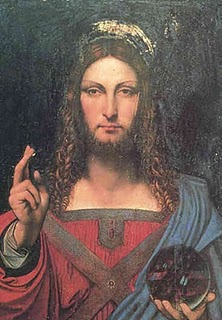

Cesare Borgia (above), however, was determined to kill Alfonso, and one night in 1501, as the Duke lay convalescing in the Palazzo, he arrived with a gang of cut-throats and ordered Lucrezia out of the room. One assassin, a professional garotter, strangled the Duke before he could cry for help. Cesare afterwards excused the attack on the grounds that Alfonso had threatened to murder him, but no one believed this.
A grieving Lucrezia was sent to the Castle of Nepi to mourn in private for her husband, and shed many bitter tears for his loss. But when her father summoned her back to the Vatican, she dutifully obeyed him, and prepared herself to submit to whoever he might choose as her third husband. Casting off her sorrow, she threw herself into a hectic round of pleasure, devised by Cesare in order to cheer her. Gossip-mongers had a field day exchanging lurid tales of these scandalous goings-on in the Vatican. On one occasion, Cesare was said to have stewn hot chestnuts across the floor of the Pope's apartment, then made naked prostitutes crawl on hands and knees with lighted candles to retrieve them. There were fertility contests, orgies, and obscene masques. It is nowhere recorded, however, that Lucrezia took part in any of these diversions. On the contrary, people were beginning to speak of her piety and her gentleness. But this was possibly mere flattery.
In 1501, Cesare chose to ally his family with the ancient and noble House of d'Este, who ruled Ferrara. But when the then Duke's son, Alfonso d'Este, aged 24, was offered Lucrezia as a bride, he refused to take to his bed a lady of such notoriety. However, his father, eager to ally himself with the powerful Borgias, threatened that he would marry Lucrezia himself if his son did not accept her. In the end, the Pope offered such a fabulous dowry with Lucrezia that d'Este was unable to refuse. A splendid wedding followed, at which the radiant bride was observed dancing with her brother Cesare, who had rid her not only of a lover but also her two previous husbands.
But Lucrezia was soon to be removed from the orbit of the dangerous Cesare. After her wedding, she bade a final farewell to her father and brother: Pope Alexander was to die in 1503, Cesare Borgia in 1507. Lucrezia had by them embarked on her new life as Duchess of Ferrara; her husband succeeded to the title in 1505. She brought to the marriage a magnificent dowry of sumptuous clothes and jewellery, exquisite works of art and luxurious furnishings. She and Alfonso d'Este (below, left and centre) made their home in the Castle of Vecchio. Against all the odds, the taciturn, promiscuous d'Este was charmed with his bride, whose grace and modesty would always captivate him.
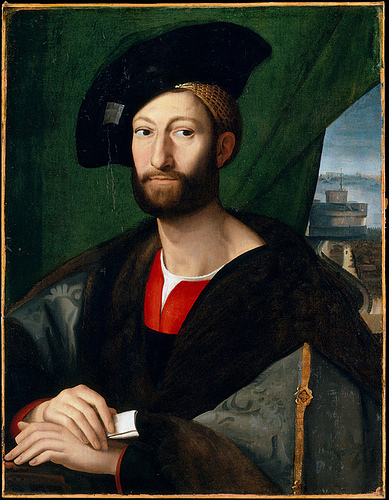

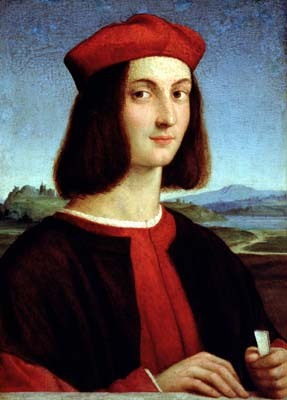
Yet the gossip persisted. Before long, Lucrezia's name was being linked with that of the poet, Pietro Bembo (above, right), who may have been her lover. It was said that his erotic poetry was inspired by the passionate hours he had spent in her bed; some evidence suggests, however, that their relationship was entirely platonic. Nevertheless, Lucrezia's husband's suspicions were sufficiently aroused for Bembo to deem it wise to remove himself to Venice in 1505. Then there was the tragic Ercole Strozzi, another young poet, who wore his devotion to the Duchess like a heart on his sleeve. There was the most appalling scandal when Strozzi was found dead in the street, hacked to death with a dagger. Lucrezia's enemies accused her of having him killed out of jealousy, as Strozzi had been about to marry another lady. Others said that he had been silenced to prevent him from revealing just how often, and in what manner, Bembo and himself had enjoyed the Duchess's favours.
Lucrezia further angered her husband when she brought to Ferrara Roderigo, her son by Alfonso of Bisceglie, and the mysterious Infante Giovanni, who were both brought up with the ducal children. When Roderigo died in 1512, Lucrezia was devastated, and retired for a while to a convent before being reunited with her husband. Giovanni lived until 1548.
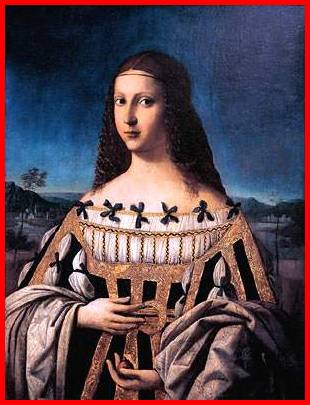
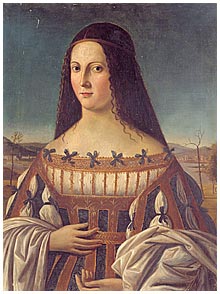
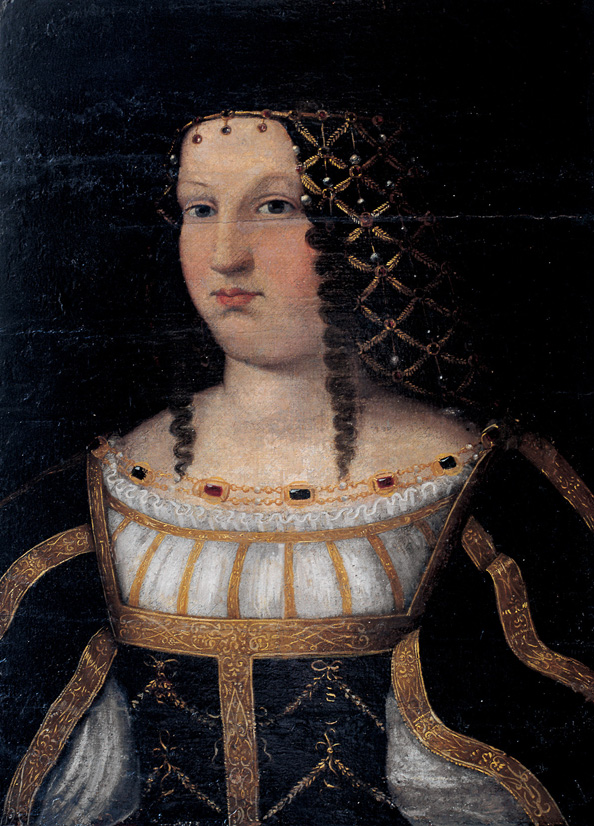

As the years passed, the old scandals were forgotten, and thanks to the efforts of the poets and men of letters whom she patronised, or who admired her, Lucrezia Borgia's image metamorphosed into that of a godly and virtuous matron, without spot of sin, merciful and kind, and a gracious patron of the arts. When she died in childbed, of puerperal fever, in 1519, bearing her eighth child, her husband the Duke deeply mourned the passing of his 'dearest wife'. She was buried in the convent of Corpus Domini, Ferrara, where he was later laid to rest beside her (above, right).
So what is the truth about Lucrezia Borgia? Was she the notorious femme fatale of popular rumour, or was she indeed a virtuous woman much wronged by those about her? Today, many think she was more sinned against than sinning, and that she was the innocent victim of ruthless, unscrupulous men. There is plenty of evidence that the truth may be rather different, and that the original verdict of historians on Lucrezia Borgia is the correct one.
(Film stills are from The Borgias, B.B.C. TV, 1981)
THE BORGIAS (composed 1981)
They left no trace, this race of poisoners,
save jewelled murals on a holy wall
in which they do appear like prisoners
locked in time, that men to come might recall
the pageantry, the naked lust, the blood,
memorials and testimony stark
to the effective vial, the tampered glove,
the dagger fast descending in the dark.
Some shudder from that far and distant time
reverberates today, this kinder age
that frowns on such as cast pearls before swine
to blot still redder history's darkest page.
That were too cold for ghosts, where do they rest
their quiet bones that once in vice were dressed?
CHAMBERCOMBE
Proposal (never submitted) for an unpublished novel by Alison Weir, 2014, with a brief extract.
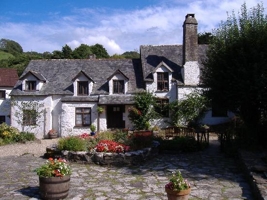

The idea for this novel was born in 1987 when I visited Chambercombe, an ancient historic manor house in north Devon. There I first encountered the legend of the secret room, a legend that may be based on fact, because certainly the room exists, although there is now no entrance to it. And there are many tales of ghosts at Chambercombe, and echoes of a past stretching back for nearly a thousand years…
In the years that followed my visit I spent a lot of time researching Chambercombe and the historical context of the legend, immersing myself in seventeenth- and eighteenth-century Devon and the story of the unfortunate Kate Oatway.
The tale I propose to tell begins in 1865, when a farmer doing roofing repairs noticed the outline of a blocked-up window. The following is part of the original draft of this story:
If it hadn't been for the poor condition of the roof, John Robins would never have had cause to wonder if there was something amiss in the farmhouse. Just after lunch he had gone out into the garden and looked up, intending to ascertain exactly which tiles needed replacing. He had been about to position his ladder against the eaves when he noticed, between his bedroom window on the upper storey and the window next to it, what seemed to be the outline of - yes, another window. A window that had at some time been blocked up and distempered over. A window that - and now his imagination was running away with him, yet the fancy would not leave him - a window that had been purposely obliterated.
He could not understand how there could be a window in that particular place. His bedroom and the living room lay behind it, but he had never noticed the outline of another window in either. But when he went upstairs to investigate, he realised to his surprise that there was a gap of at least six feet between the two rooms. There was no doubt about it. What lay behind his bedroom wall was not the next room.
He also discovered that that section of the passage wall sounded hollow, although the walls on either side were as solid as the rest. Local tradition held that Chambercombe Manor had been built in the year of the Norman Conquest of England, and certainly it dated from a time when houses had been built with walls as thick as nine feet. But this wall, made of cob, sounded hollow. He discovered that when he tapped it, with a mounting sense of excitement and, strangely, fear. To think that he'd lived in this farmhouse for fifteen years and had never ever suspected, nor asked himself why there was a passage, six feet long with steps up, between his own bedroom and the next room.
He scratched his head, wondering what to do. Should he contact Mr Trumbell, the managing agent for the manor farm, who would advise whether the landlord should be notified? Or could he, should he, take matters into his own hands and make haste to relieve his curiosity?
He frowned. Two rooms away at the opposite end of the corridor lay his wife, resting through the sultry afternoon. Two miscarriages she'd suffered, and was now three months gone with another pregnancy. He did not want to risk her taking a fright, or suffering any needless anxiety. But thanks to the thick walls of the manor and the heavy doors of great antiquity, he doubted that Mary Ann would hear if he took a pick-axe to the wall.
Well, he could not stand about all day dithering. A farmer had work to do, animals that needed to be fed, and he still hadn't noted down all that needed to be done to the roof. The tiler was coming on the morrow to name him a price for it. Even so, he knew now that on the other side of that wall there was a room that had been hidden for God knew how long. Why? Someone had deliberately sealed that room off, and bricked up its window. Someone who must have had a very good reason for doing that. And maybe, just maybe, there would be a clue as to why behind that hollow wall.
John Robins made up his mind. He descended the living room stairs to the store-room where he kept his tools – a cold little room with whitewashed walls and, incongruously, a stained-glass window at one end. Legend said it had once been a chapel when noble folk had lived at the manor, but John Robins knew little about the history of Chambercombe, and until now had been content to let the old walls keep their secrets. He took his pickaxe and went back upstairs.
In the split second before he wielded the axe, he knew again a frisson of fear, had a premonition that something bad was concealed behind the wall. Yet he was not a man to shirk the unpleasant, and of the two warring elements in his mind, curiosity and trepidation, curiosity was by far the more lively. He swung the pickaxe without further thought.
The cob wall shattered easily, as he had known it would. In a few minutes John Robins had made a hole in it about eight inches square. But he could as yet see nothing: the manor was still holding on to its secret.
Just then Mary Ann appeared at the door of her bedroom,
‘I couldn't sleep, it's so hot; the child is active today,’ she said, then stared at the hole in the wall. ‘What are you doing, Mr Robins?’
'It's nothing,' John said. 'Get back to bed, Mrs Robins, and don't bother yourself.’
But his wife's curiosity had been aroused. ‘There's a hole in it!’ She hastened to his side and peered into the opening. ‘Ugh, what a smell!’ She wrinkled her nose. ‘Rats!’
‘Go back to bed,’ John said again, more harshly than he intended. The awful smell seeping into the passage from the cavity in the wall did not, in his opinion, emanate from rats. What he suspected was something far worse, and if he was right, Mary Ann must be kept away at all cost. But Mary Ann had other ideas.
‘I'll not be treated like a child,’ she said, ‘and I think, as it's my home you're smashing up, that I've a right to know what it is you're
about.’ ;
John sighed. There seerned to be only one way to make Mary Ann see reason, and that was to tell her the truth. So he described how he had noticed the bricked-up window and discovered that the passage wall was hollow, then voiced, somewhat gently, his suspicion that something rather nasty lay behind the wall. Mary Ann's hand flew to her stomach, as if to protect her unborn infant from whatever horrors were concealed nearby, and backed away.
‘I must know what it is,’ she said.
‘Knowing is one thing,’ said her husband, ‘but you must allow me to judge whether you must see. I'll get a light.’ He passed by her into his bedroom, lit the little lamp that sat in the recess by his bed, and, holding it aloft in the passage, peered through the hole, wrinkling his nose in disgust at the stench beyond, where the air was stale, foetid and cold. He could see something large blocking his view of the room. A bed? Yes, surely, a four-poster bed, of all things. He would have to make the opening bigger.
A few moments later he looked through again. Yes indeed, there was a bed, hung with dark crimson curtains, which were pulled together, and on the walls there seemed to be ancient tapestries of the sort found in old farmhouses, usually in the best bedroom or parlour.
‘What do you see?’ Mary Ann asked from the doorway where she had retreated.
‘An old bed, some tapestries. Nothing else. I’m going in.’ John again took his pickaxe and struck at the wall. Soon he had made a space made big enough for a man to climb through. He clambered through it reluctantly, unwilling to go near that bed, and fearing what might lie within it. That smell! It hung about him in the disturbed air like a miasma, thick as the dust that had fallen in piles when he hacked through the wall.
He made himself approach the bed and take hold of the curtains; as he pulled them apart they started to disintegrate in his hands. Then he saw what lay in the bed.
‘Great God!’ he cried. ‘Oh, merciful God!’ He turned away, shaking, as Mary Ann’s anxious face appeared at the opening in the wall.t
‘What is it?’ she cried, then her eyes travelled past John to the bed and what it contained.
Downstairs in the kitchen the cook was just putting the finishing touches to an apple pie when she heard her mistress scream. Mrs Miles was a motherly soul, twenty years older than young Mrs Robins, and she shared the general anxiety about the latter's delicate condition. Presuming on her long service she ran upstairs, her hands still floury, took her mistress by the shoulders and shook her, not roughly, but with authority.
‘Hush! Hush! Ye'll harm the babe! Quiet now, Madam!’ Mary Ann stopped screaming and fell into her cook's arms, sobbing uncontrollably.
‘Horrible! Horrible! was all that she seemed capable of uttering. Mrs Miles soothed her, patting her on the back and murmuring appropriate noises, until she suddenly noticed Mr Robins emerging from the wall - a place from which he had no right to emerge, to her mind. But one look at John Robins' ashen face told her that there was trouble here. Bad trouble.
‘Help your mistress to bed, please, Mrs Miles,’ the farmer said in a strangled voice. ‘She's had a bad shock.’ What the shock had been he did not say. Mary Ann was still sobbing on Mrs Miles’s shoulder, quieter now, but still terribly distressed. The cook supported her to her bedroom, wihich contained Mary Ann’s pride and joy, an elegant Chippendale bed and cabinets. There she made her mistress lie back against the crisp clean pillows, scented with lavender, and made haste to loosen her clothing and chafe her hands. They were very cold, a sure sign of shock. Cook rang the bell on the little table. The maid appeared.
‘Run into Ilfracombe and fetch the doctor,’ said Mrs Miles. ‘Madam's had a bad turn, and I think he should look at her.’ The maid bobbed and left.
‘Thank you, Mrs Miles,’ said John Robins, coming into the room, sitting on the bed and taking his wife's hand. The cook deemed it appropriate to withdraw, and went back to her pie, shaking her head gravely.
‘My dear,’ said John, gently, ‘I warned you not to look.’
‘I had to know,’ Mary Ann said weakly. Then she broke down again. ‘I wish to God I hadn't seen..."
‘And I,’ he replied grimly.
‘What are we going to do?’ Mary Ann asked, her tears subsiding, although she was still shuddering.
‘We must inform the constable. He will know what to do. When the doctor has assured me you are all right, I'll ride into town and see him. For now I'd better make sure that the servants don't come upstairs. We don't want any panic. After all, this is nothing to do with us.’
‘How long do you think it's been there?’ asked Mary Ann.
‘A very long time. I’d give much to know how it came to be there.’
‘It was put there,’ Mary Ann said. ‘But why, we shall probably never know.’
The doctor arrived an hour later and, after examining Mrs Robins, prescribed bed rest and a tonic. Otherwise, all seemed to be well. He seemed satisfied that the attack had been brought on by his patient having taken fright while reading Mary Shelley's "Frankenstein", which was the explanation given by John for his wife's attack of the vapours.
‘A most unsuitable book for one in your condition, my dear lady,’ he admonished, ‘and I must forbid you to read it for the present. Try Mrs Gaskell or Mr Dickens.’ Mary Ann nodded meekly.
Satisfied that his wife was in no danger, John Robins rode off to Ilfracombe to lay his problem before the police. Mrs Miles brought up her mistress's tea on a tray, and sat with her while she ate it, because for some unaccountable reason Mrs Robins did not want to be alone upstairs.
‘Mrs Miles,’ she said, ‘I am in a very agitated state. There is something... Can I speak to you in confidence? Truly?’
‘Of course, Madam,’ said the cook. She would never betray her mistress's trust.
Mary Ann played nervously with the quilt. ‘You must be wondering what caused my fright today, and I feel that you should know, although the truth is not pleasant. But I am a little stronger now and able to speak of it. When Mr Robins was inspecting the roof today he noticed the outline of a bricked up window. He investigated, and found the passage wall to be hollow. He knocked through it and discovered a secret room. It has been there a long time, we think.’
She paused. The trembling had begun again.
‘Don't distress yourself, Madam,’ Mrs. Miles said tenderly.
‘No, I must tell it. I have to tell it to someone, or I will go mad. If I can talk about it, it might not seem so bad.’ She took a sip at her tonic. ‘In the room there is a bed, an old four-poster with red curtains. They fell to dust when the master touched them. It was then that he found a body in the bed.’
‘Oh Lord!’ shrieked the cook. ‘Mercy on us! A body?’
‘A skeleton, no more. Wearing a woman's nightgown and cap, as far as I could see. Heaven help me, I never want to see the likes again, nor even think of it. It lay there grinning at me, one hand on the coverlet and its head on its shoulder. It was awful!’
Cook looked fearfully towards the doorway, as if she half expected the skeleton to have left its bed and come searching for them. ‘And us never suspecting,’ she whispered. ‘And yet you know, Madam, there's always been talk amongst the servants.’
‘About what?"’ Mary Ann asked sharply.
‘Well, there are those who say they have seen a woman's spectre here. A woman in a grey gown. I always dismissed it as rubbish, and I still hold to that. But it makes you think.’
‘Indeed it does,’ said Mary Ann. Never would she admit to her cook that she, too, had once seen a lady in a grey dress, in the rose garden.
Interwoven with the story of the discovery of the secret room is the tale of Kate Oatway, a tale of wreckers, love and tragedy. It begins with the romantic marriage of her parents, William, son of the notorious wrecker, Alexander Oatway of Chambercombe, and Ellen, a young woman whose ship is lured onto the rocks of the Devon coast. Rescued by William, she falls in love with him, and they are married at Chambercombe in 1690. The following year Ellen bears a daughter, Kate, and the family go to live on the atmospheric isle of Lundy.
Time passes. In 1707 Kate, now sixteen and very beautiful, attracts the attention of a dashing naval officer, Duncan Wallis. They marry and move to Dublin, and soon afterwards Wallis is promoted to captain.
Later that year William and Ellen learn of the death of Alexander Oatway, from whom William has inherited Chambercombe, and they return there to live. It is not a happy homecoming. The manor is in disrepair and William has no money. The next year witnesses the moral decline of a once-upright man, who secretly turns to wrecking to raise cash, much to his wife’s grief. The scene is now set for the book’s horrifying climax.
In October 1708 a furious storm lashes the coastline and a large spice carrier breaks in two on the rocks of Hele Bay. The wreckers move in and steal the cargo, and amid the confusion William finds a woman lying badly disfigured and near death on the beach. Noticing that she is wearing costly jewellery, he carries her to Chambercombe and puts her to bed, where she dies minutes later. Immediately William removes her jewellery, which he knows will solve all his financial problems.
Then comes a knock at the door. It is a suspicious constable, come to ask William where he was the night before. Ellen tells him that her husband was drinking with friends at Berrynarbor. That day William hides the body of the young woman in an old priest’s hole beneath the floor of an alcove near his bedroom. In the evening he goes to the inn at Berrynarbor where he meets sailors from the wrecked ship, who tell him that the ship was under the command of a Captain Wallis, and was bound for Ilfracombe, where the Captain’s wife had intended to visit her parents, but alas, now she is lost, feared drowned.
William is struck by a terrible suspicion. He describes the clothing of the woman he found on the beach, saying he saw her, but not revealing what he has done with her. Yes, the sailors say, that was Mrs Wallis – and William realises that it was his own daughter who died and whom he has callously robbed.
He goes home and breaks the news to Ellen, who is so prostrate with grief that she suffers a stroke and dies. William dares not own up to what he has done, so he drags a bed into the alcove, lays Kate’s body in it and walls up the window and the alcove itself. He then leaves the manor and lets it to a farmer, on condition that it remains uninhabited until his own death. He dies a lonely man in 1738, leaving an account of the tragic events that had taken place thirty years earlier.
Since then, Kate Oatway’s ghost has been seen in the bedroom where she died, and felt as a cold presence in the passage by the secret room. But hers is not the only ghost at Chambercombe…
SOME OTHER IDEAS I HAD FOR BOOKS THAT NEVER MADE IT INTO PRINT:
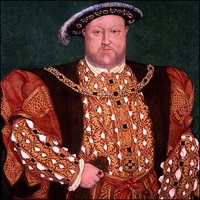
THE MISTRESSES OF HENRY VIII
Recent popular fiction, films and TV have given rise to much speculation about Henry VIII`s mistresses, including Elizabeth Blount and Mary Boleyn, and his extra-marital adventures. I had no doubt that a book about the subject could prove enormously popular.
(Alternative title: THE SIX MISTRESSES OF HENRY VIII
Elizabeth FitzWalter, Elizabeth Blount, Mary Boleyn, Madge Shelton, Joan Dobson and Anne Bassett – and a few fleeting others!)
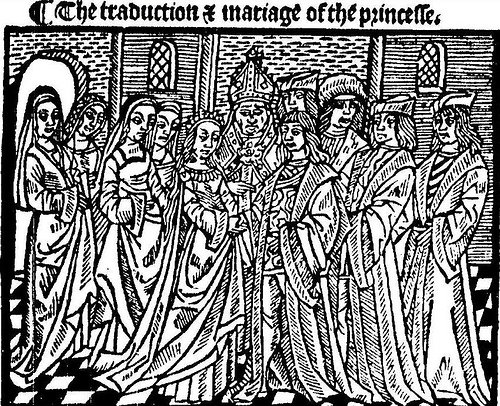
THE MARRIAGE MADE IN BLOOD: ARTHUR TUDOR, PRINCE OF WALES, AND KATHERINE OF ARAGON
Little is known about the life of Henry VIII`s elder brother Arthur, whose life is surrounded in mystery, but who has never been the subject of a biography. His marriage to Katherine of Aragon was controversial for many reasons, and ended in tragedy. A book about them would fill a gap in our knowledge of Tudor history and reveal a poignant and fascinating story.
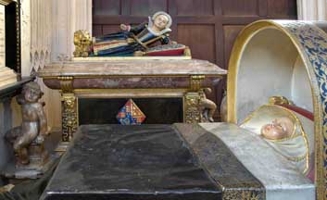
DIED YOUNG: THE LOST HEIRS TO ENGLAND
From the little-known Richard, the son of William the Conqueror who was killed in the New Forest, to Prince John, the epileptic, hidden-away son of George V, the history of the English monarchy has been littered with royal heirs who either died young or never reached their potential. This book would have told their sad, often tragic or momentous stories.
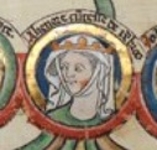

THE THREE ELEANORS
The story of the interrelated lives of three strong women: Eleanor de Montfort (1215-1275), daughter of King John and wife of Simon de Montfort, Earl of Leicester, the leader of the barons in their wars against Henry III and the founding father of the English Parliament; her sister-in-law, Eleanor of Provence (c1221-1291), the unpopular queen of Henry III; and Eleanor of Castile (c1244-1290), the beloved queen of Edward I, the son of Henry III and Eleanor of Provence. Spanning the period 1215-1291, this book would have covered the turbulent period linking my biography of Eleanor of Aquitaine, grandmother of Eleanor de Montfort, to my biography of Isabella of France, daughter-in-law of Eleanor of Castile. I wanted to describe the lives of these women and the often fraught relations between them, and set them within the context of the thirteenth century, a rich and well-documented period in English history that has not as yet attracted the interest of popular historians. The title of the book was chosen with the deliberate intention of linking it to Eleanor of Aquitaine.
CATHERINE OF BRAGANZA, QUEEN OF CHARLES II
A biography of a much-maligned and often misunderstood woman who, having been convent-educated, bore patiently her husband`s numerous affairs and the licentiousness of the Restoration court, only narrowly escaping divorce or death on the scaffold, then re-emerging as the respected ruler of Portugal. A biography is decades overdue.
GHOST STORIES
I have removed the two stories that appeared on this page as I will be including them in an anthology of ghost stories that I hope to publish. Two of them have been published: 'Anniversary', in Woman and Home, in August 2009, and 'Leila' in Woman magazine, in July 2014.
FROM MY ARCHIVES
I am often asked about my early interest in history, so have decided to include on this page selections from my archives.
In 1966, when I was fifteen, I wrote a biography of Anne Boleyn; it runs to 134 pages, and was written in a hardback exercise book, like many of my early work. Here is the first page and a list of earlier projects, none of which survive.

In 1967, after reading a biography of Richard, Earl of Cornwall, the younger brother of King John, I became fascinated by his first wife, Isabella, daughter of the legendary William the Marshal, and wrote not only a biography of her but a novel. Here is an extract from the biography, from the chapter 'A Feudal Girlhood, 1200-1214', and below it are two passages from my fictional account of the same period.

1204
It was summer, and yet the rain coursed down relentlessly. Now and again huge claps of thunder shook the sky and were followed by flashes of lightning which constantly clawed at the defenceless countryside of Deheubarth. The river churned around the great castle of Pembroke, and all the while the wind howled.
The fields of the surrounding farms were deserted; the villeins had had, of necessity, to leave their work and run for the shelter of their rude dwellings. Shivering, they huddled together for warmth. A thud heralded the swift fall of a tree struck by lightning.
Within the chapel in the castle the wailing of the wind did not penetrate. Here knelt Isabel, Countess of Pembroke and Striguil, deep in prayer and undisturbed by the raging storm outside. Here the lady of the castle would spend many hours on her knees, praying for the safe deliveries of her children or the well-being of her adored husband.
She was of the people, this Lady Isabel, and also by the devoted William, although many years his junior. William, Earl Marshal of England, adviser in chief to King John, was a man well-loved and highly respected by all who knew him.
In a turret room of the castle played the younger children of the Marshal. They were amusing themselves with the usual game of knights and dragons. Chained to a rock – or rather, tied to a stool – was the Lady Maud, aged six years, the eldest girl. Close by stood Isabella, who was ‘Princess Maud’s’ tiring woman. Isabella was two years younger than Maud. Her flaxen hair was loose to her waist, bound by a silver fillet. Her eyes were of a magnetic blue. She was a happy child and already showing signs of having inherited her father’s nobility of character.
On seeing his sons enter, the Marshal rose from his chair. Raised his hand in blessing over them all as they knelt before him. He said, ‘The time has come for you to be true knights. Your father stands accused of treason against the lord King; I, who have never wished ill to the meanest serf.’
‘Father, what will become of you?’ cried William.
‘I have already been accused before my peers. Have no fear, they would not condemn me. I am as yet under indictment only, and free to come and go. Oh my sons, we live in wicked times when justice is not the aim of kings, and I am fearful. Not for myself, but for your lady mother and your sisters, for it is the duty of all true knights to protect the fair sex. My sons, I have seen the King. He has agreed – after much persuasion – to let me retire to your mother’s estates in Ireland with her and your sisters, on condition that I leave you all here at Windsor as hostages for my good behaviour.’
Anselm began to cry. He had heard horrible tales from his nurse of the wicked deeds of the bad King, and he was afraid. He was immediately silenced by a slap on the cheek from Richard.
‘Richard!’ thundered the Marshal. ‘That is no way for a knight to behave. On must have pity on the weak and the young. Your brother is little more than a baby; he will grow to be brave in time. I counsel you to have patience. I have too many worries without you adding to them.’
Richard bowed to hide his shame.
‘My sons,’ continued the Marshal,, ‘will you do this thing?’
‘Yes, Sir,’ they all agreed.
Young William looked puzzled.
‘How long will you be away, Sir?’
The Marshal looked sad. ‘My son, how long is exile? For forever, unless the lord King should decide to recall me.’
In my teens I wrote a lot of historical plays, which I performed in a puppet theatre with hand-made cardboard characters I made myself, or behind a sheet with sound effects, like a radio play. Only one survives, and most of it is either too faded or too embarrassing to reproduce here, but here is one scene:
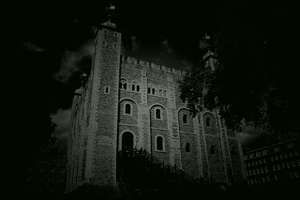
The Tower
(It is dark. Black backdrop, crenelated turrets at one side. A candle behind. Sound of water, made by rags in a bowl.)
Two warders enter from opposite sides.
First Warder: Good evening, Tom. What hour is it?
Second Warder: Nearly midnight, Will.
Will: So this sad day is over. Poor Lady Jane.
Tom: She was very brave. We laid her in yonder chapel.
Will: And her husband?
Tom: He wasn’t so brave. But it is over now.
Will: You know this is Philip of Spain’s doing.
Tom: Of course it was. He would not agree to marry Queen Mary unless Ladt Jane Grey and her husband were out of the way. They weren’t doing no harm.
Will: Tom, it is wise to let well alone. I expect the Princess Elizabeth will be arriving soon.
Tom: Yes. The Lieutenant told me he was coming in person to receive her.
Will: Brrr! It’s cold. I hate this place. It’s like hell.
Tom: Aye, they say the Tower is haunted. Young Jack, the kitchen boy, says he once saw the shadow of an axe over Tower Green one night when the moon was out.
Will: You don’t want to believe all he says. Mind you, I wouldn’t like to be alone out here at night.
Tom (as the water effects increase): Gracious, there’s the barge conveying the Princess Elizabeth!
Shouts are heard off: Ahoy there! Throw us a rope! Bring a lanthorn, it’s like a dark well down here!
Enter the Lieutenant
Lieut: Open the water gate, hurry!
Enter two soldiers
Lieut: Madam, let me assist you.
Elizabeth: No. Don’t you come near me!
LINES ON THE TOMB OF A MEDIAEVAL KNIGHT (composed before 1969)
Cold, marble hands,
impervious to sense or touch;
white, chiselled face,
staring into eternity;
fading escutcheons blazoned at the side.
What would you say, I wonder,
if you could see yourself
lying here in all your gothic glory
in a world in which
you and your kind have no place,
and where the ideals you gave your life for
are at best recounted in fairy tales?
Did you, I wonder,
hold great lands of a long-dead king?
Did you seek the hand of a lady fair? Were you wealthy, with plate at your board, having the hands of serfs to do for you?
And what good that wealth now,
when the hands and mouth that wielded power
are but dust in a cold stone tomb?
What profit the vast lands
when the only earthly home you have
is these few feet in vaulted gloom?
Wherefore the lovely lady fair
when life itself is done and gone?
Wherefore the chivalry and the deed? whispers the noonday sun.
SENLAC, OCTOBER 14th (composed 1969)
Under the thud of the hooves of the steeds
the earth quakes and shudders;
bare Saxon arms, axe-ended
foretell the day's bloody destruction,
to clash with Normans in their Norman mail
who wish to build a nation,
who have left their braided wives behind,
who have all been truly shriven.
Up to the hill surging hopelessly,
raining the arrows down mercilessly,
reigning the horses out desperately:
many men less on either side.
The stream drowns in blood,
the incarmined grass sodden
and dewy weeping for the loss of souls past and present.
Normandy retreated
and the Saxons rushed after -
they were massacred;
the ensuing bloodbath served to found a nation.
Gytha trembled where she stood
as her son died;
fathers, husbands, brothers, sons, all fell on either side.
Afterwards, they picked among the dead for the body of the warrior king;
so many had died,
and their blood was the cost of the throne
that William sat on.
Midnight approached with stealth
and the sightless moon revealed forms that had once been men,
and cowls flapping in the wind
whilst the monks who said the last office for the dying
(as they had been told to do)
averted their eyes
and in their trembling Saxon hearts '
wondered if God had forsaken them.
In 1968-9, while still at school, I wrote a three-volume history of the monarchy, running to about 450 pages.
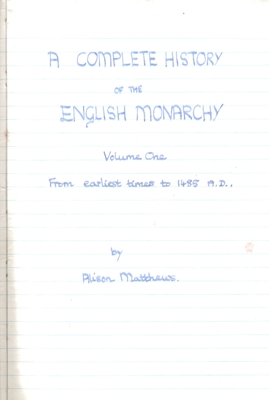
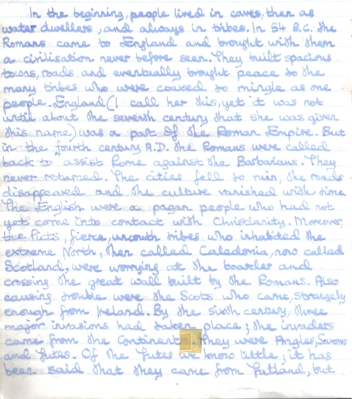
It's fascinating to read this now and see how I then viewed some of the historical figures about whom I've published books. For example, the Princes in the Tower, heavily influenced by Josphine Tey, Paul Murray Kendall and the documents about Richard III in the Jackdaw series of folders of printed reproductions:

Who killed them? The blame has been laid by the majority at Richard III's door, but there is much evidence against this. Similarly it has been attributed to the adherents of Henry Tudor, Earl of Richmond. This theory is also unlikely. Let us now examine the character of Richard III and his motives, if any, for murder.
Born in 1452, Richard was small and undersized, but definitely not 'crookbacked' (his pictures prove this); Thomas More's biography, fabulous in the extreme, is juat a piece of Tudor propaganda, and Shakespeare's play, all too often accepted as fact, is much the same thing.
If his right to the throne was absolute, Richard had no reason to wish to murder his nephews; they were illegitimate and no obstacle. Better by far to have murdered the Earl of Warwick, Clarence's son; but no harm came to that person.
Elizabeth Woodville, now that she had been assured that there was nothing to fear, had left sanctuary and was reinstalled in the palace with her daughters, and attended balls given by Richard at the time rumours [of the Princes' murder] were rampant. Would the mother of those boys socialise willingly with their murderer?
Richard III was not a model of virtue. He had three natural children, and could be ruthless, as in the case of Lord Hastings, who he sent to the block after a few minutes' notice. But he was a great soldier and a great administrator; he was the first to devise a system of bail, and he was loved by the northerners.
Maybe the correct answer to the riddle lies in the theory that the Princes were killed by a member of the anti-Woodville faction, a member of the old nobility who could not bear to see the son of a commoner on the throne. We will never know the real truth, but the evidence against Richard being the murderer is more valid than one may think.
That was my stance for 25 years, but those who have read The Princes in the Tower (1992) and Elizabeth of York (2013) will know that, after looking in greater depth at the evidence, I reached a rather different view of Richard III.
From 1970 comes a novel in which I told a highly romanticised story of Elizabeth of York and Richard III. Here are two extracts:
YORKIST QUEEN
In August Richard received a note from the Lieutenant of the Tower, informing him that both his nephews were unwell. The following day he sent William Slaughter, his servant, to see how the boys fared.
Slaughter arrived late in the evening and was shown into the royal apartment shared by the two boys. He was shocked at what he saw. Edward was almost unrecognisable, wasted and thin; his eyes and cheeks were sunken in his face and his skin was clammy. He lay sleeping in the big bed. At his side York sweated in a feverish slumber, muttering unintelligible little noises. An attendant was busy applying cold compresses to the boys’ foreheads. Slaughter was a hard man, but even he was moved at the sight of these children suffering.
‘It is worse than I thought. Get a priest. And send to Westminster – tell the King to come. Quick!’
Two hours later he was nodding off when the door opened and the Lieutenant entered, followed by a cloaked man and a priest. The priest came over to the bed and the other cast aside his cloak, revealing himself. Slaughter bowed and explained why he had thought fit to send for him. The man nodded and gazed tight-lipped upon the pitiful creatures in the bed. The priest was saying the last office for the dying, and the others piously crossed themselves.
‘Why was not told of this before?’ Richard demanded of the Lieutenant.
‘I did not know, S-Sire,’ stammered the man, who had hardly bothered to visit the two boys in his care.
Richard said nothing, but turned grimly to the bed, mouthing a silent prayer.
Both boys died within an hour of each other before midnight. When it was all over, the Lieutenant asked for his orders and was told to bury the bodies with all secrecy, but with decency, as became their parentage.
Slaughter asked why it was necessary to keep all secret.
The King turned and regarded his servant sadly.
‘Because’, he said, ‘men shall say that Richard the Third murdered his nephews.’
At Middleham the physicians and astrologers gathered around the bed of the sick Queen, trying to disguise the truth. A year at most, some thought. Others, less. But Anne, who sensed it, was calm and cheerful. She had just miscarried of the results of that night with Richard, and was very weak. Moreover, the cough was more troublesome than ever. She begged them not to inform her lord husband of her illness, but to no avail. The King must be told.
Alone, Richard wondered how bad Anne was. A messenger would not have travelled all the way south from Middleham if it were not serious. His heart beat fast. If Anne died now, he would never forgive himself for being disloyal.
Yet if Anne died now, he could marry Elizabeth. And if Anne lived, he would forever be reproaching himself for his sinful, hidden love. Anne’s hold over his heart had been a strong one, and it was not easy to break the habit of eleven years. But when he thought of Elizabeth he could put Anne right out of his mind. Elizabeth occupied his thoughts a good deal that day.
A week later the progress began. Richard summoned Elizabeth the night before, just as she had got into bed. She pulled a brocaded chamber robe over her nakedness and fastened the jewelled clasps. The trailing sleeves brushed the floor as she hurried to the royal apartments.
There, Richard awaited her, garbed in a short doublet and hose that revealed his slender hips and legs. The room, which was hung with red velvet, contained a beautiful tapestry portraying the Golden Legend, and was lit by a single candelabra on a stand by the huge bed.
Elizabeth stood rooted to the spot. Why had he summoned her here now? What did he want of her? She looked at him warily. She had not meant it to be like this.
‘Come now, sweeting,’ said Richard, pouring some wine into a golden hanap and giving it to her. ‘Let us talk. The night is young and no one will disturb us.’
She sat down on a cushioned chair, drawing her robe tighter around her. There was a silence.
Richard spoke first. ‘You think I bring you here for that,’ he said, indicating the bed. ‘It is not so, dear heart.’ He sat down and touched her goblet with his own.
‘To us, ma chere,’ he said. ‘Tu et moi!’
In the 1980s I began rewriting my history of the monarchy, but only got as far as 1037! Here is an extract from Chapter 3:
THE DANES, THE CONFESSOR, AND THE GODWINESONS.
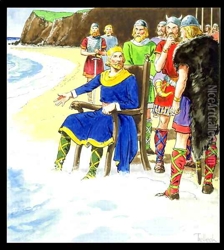
Sweyn Forkbeard, King of Denmark since 986 and a devout pagan, was a fierce, seasoned warrior of about fifty-four when he seized the crown of England in the autumn of 1013. He was not destined to enjoy his new power for long, for on 3rd February 101k, whilst attempting to subdue the townsmen of Bury St. Edmunds in Suffolk, he died of a sudden illness. He had never been crowned. His followers buried him in England - the place is unknown - but the English later sent his bones back to Denmark,
where they came to rest in Roeskild Cathedral. /
Sweyn's rule had been one of tyranny, and the Witan were determined that it should not be repeated. They therefore sent to King Ethelred the Unraed in Normandy, imploring him to return and be their ruler once more. He was, after all, of the line of Cerdic, and the Saxons were great believers in keeping to tradition. Ethelred duly returned with his wife Emma, but he was an ailing man. He died in London on 23rd April 1016, and was buried in Old St. Paul's Cathedral. The Londoners lost no time in electing his son, Edmund, as his successor. He was crowned in St. Paul's that April.
King Edmund was in his twenties, a man endowed with great physical strength, known as 'Edmund Ironside'. A year earlier he had married Edith, widow of Sigeferth, an East Anglian thane. At the time of Edmund's accession, Edith was pregnant; she later gave birth to twin sons, Edward the Atheling and Edmund.
The Witan, however, did not want Edmund as King. Two years of Ethelred's further misrule had put them off the House of Wessex, and they had now veered about in favour of the son of Sweyn Forkbeard, Canute. Canute was younger than Edmund, a good warrior, able and ruthless. The Witan felt he was better suited to reign than the son of Ethelred, so they elected him king. Inevitably, civil war on a minor scale ensued, with Edmund being forced into treachery on the field of battle in an attempt to keep his throne. He was ultimately unsuccessful, as most of his subjects seem to have had more confidence in Canute. On 30th November 1016, Edmund died at Oxford, perhaps murdered by his father's favourite, Edric Streona. He was laid to rest at Glastonbury. His infant sons grew up and fled to Hungary, where they both married Hungarian princesses: Edward married Agatha, kinswoman of the Emperor Henry III, and Edmund married Hedwig, thought to have been the daughter of King Stephen I. Sources stating that Edmund died young are probably suspect.
Canute was now undisputed King of England, an intelligent young man fully suited to his regal responsibilities. He is said by later sources to have been crowned at St. Paul's on 6th January 1017, but there is no contemporary evidence for this. To consolidate his position, and perhaps satisfy his lust, he took as his wife Emma of Normandy, the widow of Ethelred; they were married on 2nd July 1017. Emma was an ambitious woman with a love of intrigue, a fit partner for Canute. Her children by Ethelred were being reared by her kin in Normandy, and she does not seem to have cared very much for them. She bore three children during her marriage to Canute: Harthacanute, later King of England; Gunhilda, who married Henry III, Emperor of Germany, bore a daughter who entered religion, and died two years later in 1038, on the Adriatic coast, having disgraced herself by committing adultery; and an unnamed daughter who died at the age of eight - her grave may still be seen in Bosham Church, Sussex.
Emma was wise enough to turn a blind eye to her husband's liaison with Elgiva, daughter of Alfhelm, Ealdorman of Northampton. Elgiva may have been Canute's "handfast" wife in the pagan tradition of Denmark, or a repudiated wife. At all events, the union was uncanonical, although it did produce two sons, Sweyn, born around 1015, who later became King of Norway, and Harold, born at Northampton about the time of Canute's marriage to Emma. There were, however, those who doubted whether Canute was the father of either of these children. Elgiva died around 1044.
Although Canute succeeded as King of Denmark in 1019, and conquered Norway in 1028, England was always his priority. Unlike his father, who had treated England as a mere satellite of Denmark, Canute went out of his way to be as English as possible. He won great popularity with his subjects by decreeing that St. Dunstan's Day should be kept as a holiday. He was at times cruel when it came to dispensing justice, but by and large he ruled wisely and well. There is a popular legend that bears witness to his renowned wisdom: his courtiers once flattered him by saying he could command the sea itself to obey him. Canute had himself carried to the shore on a throne - this may have been on the banks of the Thames beside his new palace at Westminster - and commanded the sea to retreat. Of course it did not, and when the waves lapped at his feet, the King reminded his courtiers that the power of an earthly King was "frivolous and vain" compared with "that great Power who rules the elements".
Canute had been baptised at the beginning of his reign, and he embraced his new faith with all the enthusiasm of a convert. He died at Shaftesbury on 12th November 1035, bequeathing his crown to Harthacanute, the son borne by Emma.
In the late 60s, much impressed by the play 'Everyman', I tried my hand at writing a morality play:
THE KING'S DILEMMA is a play written in the style of a medieval pageant play. It is a moral play. The medieval Gilds produced such plays, which were performed in church crypts or in the open air for the greater benefit of the community. The medieval Church did not permit the laity to read the Bible, which was then in Latin, and anyway the uneducated section of the community - and that accounted for a great deal - could not read. It was through the pageant plays as well as lessons from the clergy, that ordinary poor people learned about God and Scripture.
The medieval world was governed by the laws set down in Holy Scripture and sustained a firm belief in the Seven Sacraments, one of which was marriage, the subject of the play. There are two different themes, the first being absolute obedience
to the laws of God, invoking the virtues of faith, obedience, humility and love. The second shows the forces of the power of God as opposed to the powers of the Devil as seen by the medieval world. Lucifer fell from Heaven and was given the right to claim all who sinned without repentance. God had the power to elevate those who came to Him in humility and repentance, and who cast away all earthly pride.
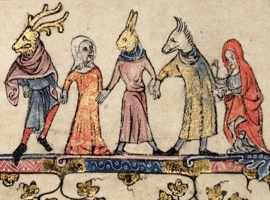
Dramatis Personnae
King Henry
Queen Alienora
Rosamund.
The Common Man
I. (Enter the Villein)
Vill.
Such strange events have run the course of time
I fear the future more than I can say
King Henry and his wife are sadly parted
And all forgot is love this troubled day
The King's unruly sons have risen hotly
Against their father; right and might are not
And Queen A'enor with mother's love and weakness
With sons not husband threw she in her lot
0 Sarum mound of Salisbury raised
You captor of my lady Queen
Deliver up your prey I beg ye
While bluebirds sing and all the leaves are green (enter Rosamund)
(The play runs to eight foolscap pages.)
In the late 60s, fascinated by the fourteenth century after reading Anya Seton’s novel, Katherine, I wrote a novel called ‘Uncrowned Queen’ about Alice Perrers, the notorious mistress of Edward III. Here is an extract:

One day the King went to his window, as he often did, to gaze out at the palace gardens bordering the river. On this particular morning they were deserted save for a young woman who was playing with a little child. The woman wore black velvet in mourning for the Queen, and a gold filet crowned her raven tresses, which covered her like a cloak. Suddenly she turned and the King found himself looking at the temptress of his dreams.
He beckoned to William of Wykeham, who had been helping him with affairs of state. Wykeham rose and came to the window, his short rotund figure in comical contrast with the King’s tall and lean one.
‘That is the Dame de Windsor, is it not?’ said Edward.
‘Yes, Sire, she who was formerly called Alice Perrers,’ said Wykeham, wondering why on earth the King should ask.
‘You will go and tell her that I wish to see her,’ Edward ordered. ‘And you will see that we are left alone.’
When the astonished prelate had left, Edward the King found his blood racing through his temples and his heart thumping. He wondered what had prompted him to act with such careless abandon. Well, Wykeham would have to think what he liked. Edward was the King, was he not?
Minutes later a bewildered Alice Perrers found herself in the presence of the King of England. She sank into a deep curtsey, bending low so as to hide the flush on her face. At close proximity, Edward certainly had a magnetic appeal, despite his age.
‘Rise, Lady,’ he said, advancing slowly towards her.
Alice did so, keeping her eyes down.
‘Be seated,’ he went on, indicating a chair. Alice sank into it.
Edward paced up and down. ‘Madam, I have long felt a desire to converse with you, and I hope that you will consider it a pleasure to honour me with your company.’
Alice smiled. ‘Your Grace is kind,’ she murmured.
‘You know, you have a great resemblance to – to her.’
‘I, Sire?’
‘A very great resemblance. You could almost be her.’
‘Your Grace flatters me.’
‘No, Madame, I do not flatter anyone. I merely state facts. And it is a fact, Madame, that I have long wished for us to become acquainted.’
Alice fluttered her eyelashes. ‘Your Grace is not the only one to have had that wish.’
‘Then I may aspire to your favour?’
‘Sire, you could aspire to be no higher than you are now in my estimation.’
Edward turned away and walked to the window. It was some time before he spoke again, and when he did there was great emotion in his voice.
‘Madame, I pray you will do me the honour of presiding over my table tonight.’ This was no merely a request, Alice knew; it was a command. She smiled.
‘I thank your Grace for the invitation.’
‘I shall await you here after Vespers.’
Alice curtseyed and swept out of the room, leaving the King more confused than before. Having now seen the woman, his feelings had intensified. But, dear God, he wished she was Philippa!
The Alice Perrers novel is written in a bound exercise book that was originally going to contain 'The English Royal House in the Middle Ages'. The chapter on William I is complete - the beginning and end passages are reproduced below - and that on William II half-finished. The last chapter was to have been called 'Richard III - a Much Maligned Man'.


The novel on Alice Perrers was based on research I did in 1968 for a sixth-form project, a biography of Edward III, an extract of which appears below:

In 1970 I wrote a novel, 'The Lady', about Anne Boleyn, with twenty-three narrators. Using multiple narrators was a device I would employ thirty-six years later in my first published novel, Innocent Traitor. Here is the foreward from that earlier novel, the list of contents, and extracts from a couple of chapters. They are unedited.
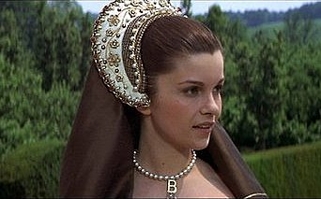
Early influences: 'Anne of the Thousand Days' and 'A Man For All Seasons'
In the bewitching and enigmatic Anne Boleyn, ambition was the dominant streak of character - ambition which sent her soaring to unprecedented heights for a woman of her station; ambition which sent her to her doom. But it is not just the story of one woman: it is the story of three women whose lives were closely interwoven: Catherine of Aragon, the first wife of Henry VIII, Anne herself, his second wife, and Jane Seymour, his third wife. It is a story of conflicting opinions, complex relationships and twists of fate. Here, through the eyes of those who knew her, is that same Anne Boleyn.... but she does not speak for herself, as that wauld necessitate the solving of mysteries that have never been solved; the truth of which was not known even in Anne's own lifetime.
The enigma remains - but the story can be retold.
CONTENTS
1. Elizabeth Howard's Tale, 1509
2. Sir Thomas Boleyn's Tale, 1514
3. Mary Tudor's Tale, 1514
4. Marguerite of Navarre's Tale, 1520
5. Mary Boleyn's Tale, 1522
6. Henry Percy's Tale, 1523
7. The Earl of Northumberland's Tale, 1523
8. King Henry's Tale, 1527
9. Doctor Butts' Tale, 1528
10. Queen Catherine's Tale, 1529
11. Thomas Cranmer's Tale, 1531
12. King Francis's Tale, 1532
13. Rriar Brown's Tale, 1533
14. The Duchess of Norfolk's Tale, 1533
15. The Lady Mary's Tale, 1533
16. Anne Savile's Tale, 1534
17. Sir Thomas lore's Tale, 1535
18. Eustache Chapuys1 Tale, 1536
19. Mark Smeaton's Tale, 1536
20. Sir William Kingston's Tale, 1536
21. George Boleyn's Tale, 1536
22. Mary Wyatt's Tale, 1536
23. Jane Seymour's Tale, 1536
Epilogue: Aftermath
From Sir Thomas More's Tale, 1535
It is a sad thing when a man must die for doing his conscience. Tomorrow I shall walk out on to Tower Hill and sacrifice my head on the executioner's block because I will not swear to the Oath of Supremacy.
Why will I not take this oath, you might ask? I will tell you while there is still time. The Pope - as the Spiritual Descendant of St. Peter - holds authority from Christ himself, and no one, no, not even King Henry the Eighth, can wrest that authority from him. It cannot be done. The King may call himself Head of the Church of England but no Act of Parliament can make him so because the Pope alone is the Head of Christ's Church on earth.
There are those who say that His Grace's passion for Anne Boleyn caused the schism, but this is not strictly true. Everyone knows that there has been intermittent strife between the Kings of England and the Papacy since the Conquest, and no one can deny the fact that the English Church needs reformation. Why, years ago, Wolsey was urging the King to make an enquiry into the state of the religious houses. The Great Matter was therefore the straw that broke the camel's back, so to speak. But I think that few knew just how final and terrible that break was to be. I hear that they are dissolving some of the lesser houses already. Cromwell's doing. The King is badly in need of money (having spent it all on his mistress), so Master Cromwell suggests an enquiry into the state of the religious houses, many of which possess great wealth. And what happens but that the King's commissioners, well-primed beforehand by our friend Cromwell, find that there is an appalling state of moral laxity in these houses? Then the report goes back to the King's Grace who, because he is Head of the Church and has a conscience, finds it his painful duty to order the dissolution of these unfortunate establishments, and the confiscation of their property. And where is it all leading to? I thank God that I shall not be alive to find out. And Queen Anne? Oh, she may dance today and make merry, poor lady, for tomorrow I fear her head may dance to a different tune. It is no secret that the King grows increasingly impatient for a son and increasingly impatient with his wife's temper. Envy Anne Boleyn not, then, for she is brewing a lot of trouble for herself.
I saw Margaret today. For the last time. Oh my Meg, you are the only thing your father regrets leaving in this world. You sat there on that rough bench, your hands demurely folded on your clean pressed skirts, and I thought that I should die, so great was the pain of knowing I would never see you again. But I see you now, Meg: I see you happy with young Roper at Chelsea; I see you with your little ones clinging to your skirts; I see you as a little girl in Bucklersbury, picking flowers, your hair a tumble of flaxen curls; I see you at your desk, reading the books you love so well; you are always with me, Meg, and you will be with me in my last minutes on earth, right unto the end.
Our time together was short as usual. The gaoler has his orders and dare not disobey them, poor man . You left in a flutter, head bent under your linen coif to hide your tears. And you clung to me tightly, too choked for speech, as I bade you comfort Alice my wife, your stepmother.
Oh Alice, never did I teach you to read. "Master More," you would say from behind your ranks of rolling-pins and pots, "the day I learn me to read, pigs'll fly." And we used to enjoy the joke, though we had heard it a hundred times. Yes Alice, stout-hearted companion of mylatter years, you were gruff and unbending at times and you ruled me and mine like a general, but you were true, and I think verily that you loved me, even if you wouldn't say so.
They say that when a man drowns he sees his whole life unfold before his very eyes. My life I can see clearly - indeed, since my condemnation, it seems that I have shaken off my previous self and become another. You would not credit it but there is relief.in death.
From George Boleyn’s Tale, 1536
“I still love her. I will love her until I die!" Wyatt burst into tears and buried his head-in his hands.
There is something terrible about a man crying. Norrys looked away while I got up and paced around the cell.
"God curse that bitch Jane."
"And her namesake, Madam Seymour,” Norrys spat. "You can wager your last groat that she's behind all this."
I heeded him not. In a frenzy of rage, I began to storm and rail against the faithless sow I had been forced to marry.
"I'd like to strangle her.... I wish I could get my hands on her."
"Calm down, old man," Norrys said firmly. I sank exhausted to a stool. But all the time there was this growing awareness that the sands were running out... I'm going to die, I'm going to die.
Then suddenly I felt calm. I could face it. The panic left me and I felt strong again. Let them do their worst... I would not flinch. Yes, I could even calmly submit to the hideous death that was served to all traitors if the King was not inclined to mercy.
I thought of my home, beautiful Hever, the home I should never now inherit. Peaceful Hever, nestling deep in the heart of Kent... the gardens would be coming into bloom about now and the villagers would be making ready for their midsummer festival. I will never see Hever again, nor will her walls echo to Anne's musical laughter.
I thought of my father, who would now be squirming under the King's dire displeasure. Doubtless the old devil has been loudest of all in decrying us both in order to save his own-scraggy neck.
My reverie was broken by the entry of the Lieutenant, Kingston, who fixed a torch on to the wall.
"My lord Rochford," he said, bowing, "it is my heavy duty to inform you that your execution will take place the day after tomorrow, and will be by the axe. The King's Grace was pleased to show clemency."
"Pray, good Kingston, thank the King for me," I replied. Surely it was not my death that we were discussing? /
"And the Queen?" whispered Wyatt.
"Lady Pembroke's fate hangs in the balance at the moment. Her execution is tentatively set for May the eighteenth, which is Thursday. But I fear I am not allowed to speak further on the matter."
He turned to Norrys. "Sir Henry, you also will die by the axe with his lordship here, Sir Francis Weston and William Brereton."
"What of Smeaton?" Norrys asked.
"Because of his lowly birth, he is to hang. As I have said, the executions will take place on Wednesday on Tower Hill. A priest will be here later tonight to attend to the comfort of your souls. I bid you good even."
He left.
Wyatt got up. I glanced at the scrap of paper on which he had been writing.
"Ah, Mark'.
A time thou hadst above thy poor degree...."
"More poetry?" I smiled faintly.
"Aye. I always write better verse when I am in a melancholy mood."
"It is good," Norrys said. "I wonder what you will write of me."
"The truth. For all posterity to see. But mostly... for her."
"She is innocent," Norrys said vehemently. "Thank God I did not betray her honest name as the coward Smeaton did. I shall protest her innocence on the scaffold."
"I wouldn't if I were you," Wyatt cut in. "Do you want the King to consficate your property? Do you want your wife and your little ones to starve?"
Norrys was silent. I said: "I care not at all if my wife starves. May she rot in hell. It is my son for whom I grieve. He will grow up to believe that his father was a pervert and a traitor."
"Which is why I am writing these mean lines," Wyatt said.
"Gentle Wyatt. You-were ever a true friend to me and mine."
"To her," he answered. 'I will not have it said that she was an adulteress and a whore. It is all right for you - I'd change places with you any day - you are going to die, you will not live to endure her death. But I - I, who love her, must live through it, must bear the horror and the desolation to the end of my days. I will have to face life without her, in daily contact with the man who murdered her."
"Have no fear," I said, "you will not be received back at court. The King will want no reminders."
Wyatt shrugged. "What matter? My life as such will end the day she dies."
He picked up the lute again and struck a plaintive chord. Head buried in my hands, I wept as he sang:
"Farewell my lute, this is the last
Labour that thou and I shall waste,
For ended is that we begun,
My lute be still, for I have, done."
Some years later I began another novel about Anne Boleyn. Here is the opening page, set in the year 1509.
Lady Elizabeth Boleyn was ready to drop with exhaustion. The journey from London had been arduous to say the-least, so congested were the roads, and traffic had been at a standstill. Nevertheless, thought her ladyship, it had all been worth it. Worth it for the thrill of attending the young King coronation with its attendant pageants and festivities, and most of all for the pleasure of looking upon the manly beauty of the new sovereign, Henry VIII. Elizabeth was still a young woman and able to be stirred by such golden good looks.
Her husband, riding beside her along the twilight lanes of Kent, was a severe looking man, not handsome, but of that peculiarly English stamp. He was amiable and ambitious to rise in the world. The first step up the ladder to political eminence had been his marriage to the daughter of Thomas Howard, son of the Duke of Norfolk who had fallen fighting for the last Plantagenet King at Bosworth in 1485. For this treason the usurping Tudor, King Henry VII, had kept the Duke's son under close surveillance, although that had not been really necessary. Thomas Howard proved himself as faithful a servant to Henry VII as his father had been to Richard III, and for this Henry VIII would shortly reward him by the restoration of the family titles and lands.
It was during the years of Howard's political eclipse that Sir Thomas Boleyn had won the hand of his daughter Elizabeth. Thomas himself came of good Norfolk stock, his forbears farmers and tradesmen. Not good enough in normal circumstances for the granddaughter of a Duke, but then Thomas Boleyn had always been lucky. He did have some claim to nobility through his mother, a descendant of Edward I, and his grandfather had been Lord Mayor of London. He was fortunate in that the new
Tudor monarchs preferred to have around them men of his sort than the great magnates. There were few of them left anyway, most of the great aristocratic houses having being decimated during the civil wars that had ended with Bosworth and a new royal dynasty with a very dubious title._
Thomas was well aware that he was ranked among the new men. As he rode along, his thoughts were concentrated on the advantages to be had from the favour of the new King, an untried and doubtless malleable youth of eighteen. Impressive though, Thomas had to admit; Henry was virtuous, learned, pious and courageous. Men were heralding his accession as the dawn of a new golden age. The loud acclaim of the people over the last week or so seemed to endorse this view. Thomas resolved to return to court as soon as he could be done with estate business. There were almost certainly rich rewards to be had by those who were astute enough to gain the ear of the new monarch.
It was getting darker, but the lights of Edenbridge were in sight. Elizabeth thanked God she would be sleeping in her own bed tonight instead of in the crowded, stuffy inn in Southwark. And the Kentish air was sweet too, after the stink of London with its filthy streets and noisy, jostling crowds, too often drunk on the free wine that flowed through the conduits in the King's honour. Elizabeth hoped that Simonette had allowed the children to stay up to see their parents; she could not wait to see their eager faces when she described to them the splendours of the coronation and the court.
Thomas and Elizabeth had been married for ten years and had had as many children, although only three were now living. Nor would there be any more; the birth of the last babe had nearly killed his mother. Elizabeth never passed Hever Church without a lump rising in her throat at the thought of the fruits of her body, whose time on earth had been so short, lying therein.
Soon afterwards I wrote an unfinished biography of Anne Boleyn (as far as 1528), in which I took a far less romantic view. Here is the introduction:
Anne Boleyn has always presented a problem to the historian because her contemporaries, and those who were her biographers after her death, were without exception prejudiced in their attitudes towards her. Even today, her life and character are popular subjects for controversy. The truth about Anne will never be fully known. To some, she is a tragic figure, to others a mere adventuress who got more than she bargained for, and to some (although nowadays these are a small minority) the embodiment of sinfulness.
Anne of course had the misfortune to be compared with her rival, that mirror of pious virtue, Catherine of Aragon. Few people would bear favourable comparison with such a woman, but even allowing for this, the bald facts of Anne's career are hardly a recommendation for the saintly qualities conferred on her by certain Elizabethan writers. But neither is the extremely hostile view of Catherine's partisans the whole picture, although it is probably nearer the truth.
The sad fact is that comparatively little is known about this woman who was so instrumental in changing the course of England's history, and who was the catalyst that sparked off the Reformation. Even her date of birth is the subject of great dispute; her early years are clouded in mystery and contradiction, and her marriage itself took place in such secrecy that even the great men of the court were hard put to it to say where and when, and even if, it had taken place. The best documented part of Anne Boleyn1s life is the period she spent in the Tower of London before her execution, when a day by day account of her doings was rendered to the King's minister, Thomas Cromwell, who preserved his papers for posterity to read. Indeed, the Anne who appeared on the scaffold, displaying great courage and dignity in the face of death, hardly seems to be the same woman who, years before, had schemed and plotted to achieve the throne, and who would not have stopped at murder had she had the opportunity. Had Anne not met the end she did, she would no doubt have gone down in history as a figure of infamy, with few good points to redeem her reputation, and which is certainly the way in which the majority of her husband’s subjects viewed her. But instead, the succeeding centuries have enveloped her name in romantic legend, so that within a very short time she came to be known as a wronged wife, whose wicked husband murdered her in order to marry her lady-in-waiting.
This is obviously a much distorted picture. If Anne had had her way both Catherine of Aragon and her daughter would have gone to the block: so much is clear in contemporary records and letters. But because Henry VIII would not consent to this ultimate atrocity, Anne had to content herself with a campaign of persecution as relentless as it was cruel. This is all conveniently forgotten by historians who allow themselves to be carried away by the harrowing descriptions of Anne's last days, and the remembrance that she left behind her a daughter not yet three.
Also from the 80s I have the remains of another novel called 'Salle', set in the fifteenth-century and based on research I did about the ancestry of the Boleyns and their circle in Norfolk.
I first saw John Mauteby across the great solar at Kirk Hall Manor. It was, I remember, at one of the frequent family gatherings held in Salle, where everybody was somehow - no matter how distantly - related. The Mautebys were distant connections of ours, if somewhat better bred, and therefore we were often asked to dine with them along with others of the local gentry, such as the Boleyns and the Kerdestons.
On this particular evening, it was decided by the older people present that the younger ones should provide the after-dinner entertainment, and it came as no surprise to me that I was asked to sing, for men praised,my voice and had done since early girlhood. Hence I was accustomed to displaying my talents in public, and knew no shyness. And on that night I was more than ordinarily confident, knowing myself beautiful into the bargain in the black velvet dress with the gold-embroidered hem. Being the only child of doting parents, I was perhaps hopelessly spoilt, and doubtless there were many watching me who concurred in this view. But I did not care: I was seventeen, and endowed with more than my share of looks, and I thought the world
was at my feet.
Nevertheless, I maintained an air of maidenly modesty such as my grandmother Aldrych would have approved of, and as Stephen Kerdeston strummed the opening chords of my song on his lute, I seated myself demurely on the settle beside him and fastened my eyes upon my daintily clasped hands. Then I began to sing, and I knew the whole company was spellbound.
Someone was looking at me very intensely; I did not so much see this as sense it, and when I ventured to take a surreptitious glance about the room, I realised that the twinkling eyes of John Mauteby, the heir to Kirk Hall, were riveted upon me. Then I felt a strange sensation, as if my stomach was caving in and my spine was in the grip of freezing claws. I could hardly draw breath to sing another note, although somehow I managed to continue without sounding too squeaky. For in that moment some change took place in me. Eyes met in recognition, like knew like, love was born - and I was never the same again.
The recital over, I returned to my place next to my parents, my heart pounding. Father murmured, "Well done, my dear", and mother beamed with pride at the polite applause that had greeted my efforts. And still John was looking at me.
Later, it was his turn to sing. It was said that he had a fine voice, but because he had been away at Cambridge University for some years, few of us had had the pleasure of listening to him. I had not seen him since his return, and I understood that he had been busy assisting his father in the administration of the manor court. And one could tell that between father and son there existed a strong bond of affection.
I watched trembling as John Mauteby took the lute from Stephen and settled himself on a stool. He was very tall and very fair, with light blue eyes, an aquiline nose, and love-locks that fell nearly to his shoulders. Like me, he was habited entirely in black velvet, both houppelande and cap, which gave him an added dignity to that which was already innate in him.
But he sang terribly; his voice was shaky and hoarse, and did not do justice to the ballad it rendered, a beautiful ballad entitled 'The Lover’s Lament'. And I knew, intuitively, that he sang it for me. There was from the first between us that understanding that needs no words.
The song ended. Then the guests descended to the Great Hall to partake of the cold supper laid out on the high table. Sir John and Lady Mauteby stood by, genial and smiling, and I felt an indescribable affinity with them, which was surprising as I had hardly exchanged more than a pleasantry with either.
My parents, having partaken of cold roast chicken, withdrew to the warmth of the blazing fire, and I was about to follow them when I felt the urgent pressure of a hand on my arm. I swung round to find myself looking up into the admiring eyes of John Mauteby. My knees turned to water.
“Come, I beg of you," he said, and I allowed myself to be led from the hall to the empty solar upstairs.
"I cannot stay long," I said. "I might be missed. I have my reputation to think of.’
"Your reputation is safe with me," said John, and my resistance melted. "What is your name?"
"Catherine," 1 answered. "Catherine Ryghtwys."
"Has anyone ever told you how lovely you are?"
"They have now!" I laughed, but I was trembling.
"You are cold," said John, full of concern. "I'll get a cloak."
"There's no need," I said. "I am alright."
There was a silence. Both of us were trying to put into words the thing in our hearts. But there was no need.
"You know, don't you," said John, covering my hand with his and gazing into my eyes. "I mean, you are aware of what happened tonight."
I nodded, speechless.
"It defies all reason, of course," he said. "This kind of thing only belongs in romances, we are told, and yet..." He was treading carefully. We were, as yet, unsure of each other, and my experience of men was limited.
My thoughts were in turmoil. There was no future in it; he, the heir to hundreds of acres and a baronetcy, I the daughter of a prosperous but relatively lowly merchant. In a small community like ours, such an alliance would be frowned upon, censured.
I suppose my inner conflict registered itself in my eyes, for John squeezed my hand oven harder, as if to reassure me, and he would have kissed my cheek had I not drawn away.
"I must go," I cried, breathless. "My father and mother will be looking for me." And without a backward glance I fled out of the solar and down the stairs.
I had not been missed. Father was still discussing the latest price of corn with Geoffrey Boleyn, and Mother was busy admiring Lady Mauteby's collection of silver and gold-plate. I wandered about the hall, making small-talk with friends and acquaintances, but I could not concentrate. My eyes kept straying around me, searching for one face. But it was not to be seen.
Below are the opening page of an unfinished novel about Eleanor of Castile, queen of Edward I (This was written in the 1970s, when I spent several years researching the medieval queens of England)
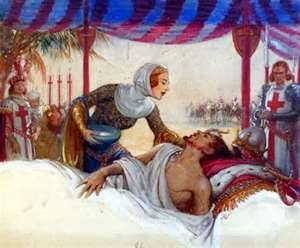
It was full autumn when the Lord Edward came to Burgos, accompanied by Madam Queen Eleanor, his mother. The treaty being signed – the treaty that was to bring an end to the war in Gascony between England and Castile – the way was now clear for the celebration of the marriage that was to further unite the two kingdoms in bonds of friendship. And thus, with great pageant and display, King Alfonso had ridden out to greet his future brother-in-law.
The bride, Dona Eleanora, was not of the party. Castilian etiquette dictated that a man might not look upon the face of his future wife until he received her from the hands of her father at God’s altar. Until then, Eleanora would not see her intended spouse.
Eleanora did not know whether she minded this or not. At ten, most men seemed old to her, although she knew that the Lord Edward was but in his sixteenth year. And she had been drilled by her mother, Madam Queen Juana, to accept the husband chosen for her, so it was immaterial to Eleanora whether she married this English prince or any other, save for the dismal prospect of leaving her beloved Castile and her even-more-beloved mother.
As the youngest daughter of the ruling house, Eleanora had been made much of. Her brother Alfonso, king these past two years since the death of their father, was twenty-odd years her senior. He cherished his little sister, even more than he cherished astrology. His mother had died a long while before Eleanora was born, and then King Fernando had married her own mother. Juana, Countess of Ponthieu and Montreuil, was French by birth and a great heiress. As she had no son, all her lands would come to Eleanora one day. She was a very great lady, both by birth and by courtesy, and had not lacked for suitors in her youth – one had been King Henry of England, father of the Lord Edward – but she had at length given her whole heart to Fernando of Castile, whose Queen she had become. In death Fernando was rapidly acquiring a reputation as a saint; he had been a good man in life, having driven the wicked Infidel out of his kingdom and reconquered part of it for Christ. Well could he rest in peace in his tomb at Las Huelgas, his earthly labours done.
There had been but one child of his marriage to Juana, Eleanora. Born in the year of grace 1244, she had grown up to be a gentle, sedate child, beloved by kinsfolk and servants alike. Although she was the darling of her family, their petting had not spoiled her, only made her the sweeter by nature. Long red-gold hair – inherited from her Plantagenet ancestors – framed her delicate oval face, untouched as yet by the contours of womanhood; and in her bearing she was as lithe as a well-bred damsel could be. Even now, noted her duenna, with the shouts of the crowds heralding the arrival of her bridegroom, she did not betray any emotion; there was no unseemly blush or improper eagerness.
A MEDITATION ON THE TOMBS IN THE BARDOLF AISLE, MAPLEDURHAM CHURCH (composed 1979)
They quietly rest in pious stone
who once in England's brightest day
displayed their fearful chivalry;
who, in the tumult of the dust
rode thundrous in the tourney's heat
in other summers, other noons.
Forgotten in the rush of time,
they lie here, but a heap of bones
concealed within a painted tomb,
these noble flowers of knighthood that
were young when Man was innocent,
who to their loud memorial bring
bright fame in colours bold, still fresh
from centuries long ago; their deeds
a single moment lost in time,
in ages, in eternity; their valour
shrined forever in this peaceful place
where ever do the righteous lay serene,
their guiltless past portending change, as now
when men may look, may judge, may even praise.
Sometime in the 1980s I began work on a novel, ‘A Certain Young Lady’ about Jane Seymour, the third wife of Henry VIII. Here are the first few pages.
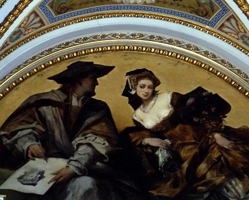
On 10th September in the year of grace 1535, King Henry VIII was in the midst of his annual autumn progress. This year he had chosen to honour the south-western shires of his realm, and he was on that day bound for Wulfhall, a half-timbered manor house on the outskirts of Savernake Forest in Wiltshire. His Highness had heard good reports of the hunting to be had in the vicinity, and was visiting with a small party of gentlemen.
It was late afternoon when the royal entourage sighted their destination. As they rode past the fields where their host's flocks grazed peacefully, they could see the manor house ahead of them, surrounded by pretty gardens and pleasaunces. Parts of it looked at least three centuries old, but it had been added to over the years, and apparently boasted a new-fangled long gallery running the length of one wing. The King, who was interested in architecture, was eager to see it.
Waiting at the great porch was Sir John Seymour, owner of this pile, administrator, diplomat, Sheriff of Wiltshire, Dorset and Somerset, Justice of the Peace and hereditary Ranger of Savernake Forest. Great as he was in his own part of the world, he was yet humble fry in the presence of Henry Tudor, as he knelt by his sovereign's stirrup.
"I bid your Grace welcome," he said. "We are honoured to have your Grace under our roof." The King dismounted and thanked Sir John, then proceeded with him into the inner courtyard, his retinue following. In the fabled long gallery, freshly whitewashed and painted for the occasion, Lady Seymour and her children waited with refreshments, after which the King was shown into the best bedchamber so that he could refresh himself after his ride.
Sipping wine brought by a page, Henry strode to the mullioned window and looked out over the neat, formal flowerbeds. Late roses still bloomed there, and a wasp drowsed lazily on the air. How quiet and restful it was here. Just what a man needed, when he was so troubled in mind and beset by cares. For until now it had not been the most enjoyable of progresses. He was supposed to be off duty - if a King can ever be said to be off duty - but affairs of state were very much on his mind. And, it must be admitted, affairs of a domestic nature also.
The worst of it was his conscience, which would plague him when he expected to be enjoying himself. His conscience told him that he had, two months ago, put to death two very fine men, Sir Thomas More and John Fisher, Bishop of Rochester. Both had faced the block because they could neither of them could see their way to acknowledge their King as Supreme Head of the Church of England, a title he had assumed upon his momentous break with the Church of Rome last year. He had tried to tell himself that he had done the right thing, but his conscience whispered that this time he had gone just that little bit too far.
It was all her fault, the woman who had to a great extent been the cause of the break with Rome and the political and religious turmoil into which his realm had been plunged: his Queen, Anne Boleyn, who was proving herself to be most unsatisfactory in every way. Henry had loved her passionately once, for many long and tortuous years, but her attraction for him had long since dwindled. Her temper was erratic, and she threw embarrassing tantrums in public, something her husband found quite humiliating, being used as he was to decorous and pious females. But the chief fault in the Queen was that she had so far failed to present him with the male heir the country so urgently needed. Henry was forty-four, and panicky about what might happen should he die without leaving a son to succeed him.
The spectre of civil war loomed large in his imagination. He had now been married to Anne for three disastrous years, and in that time she had given him one daughter, Elizabeth, and suffered a succession of miscarriages. Now she said she was pregnant again, but the King had learned not to be optimistic. He had been through this charade before with his first wife, Katherine of Aragon, who he had put aside in order to marry Anne. He sighed when he remembered the furore that had caused, and tried to remember what it had been about Anne that had provoked him to such madness. The great passion he had nurtured for years had not survived their secret wedding, and there had been mistresses, much to Anne's loudly voiced chagrin. She had even dared to upbraid him in public, much to his fury.
Well now, for a wvhile at least he was free of her, having left her behind to rest, for she was at the queasy stage, and most unattractive with it. He was among his gentlemen, company in which he could relax, and his host was a genial man who, like himself, had a past.
The wine goblet was empty now, and he sent the page out for more. Through the open window he could smell meat roasting. God, he was hungry. How long until supper?
There came a knock, and Sir Francis Bryan, one of the wilder members of his party, entered.
"Your Grace, I am informed that supper will be served at six."
"Good," said the King. "I shall change. Where's that page?"
"Gone to the cellars, I believe. Oh, and I've looked over the talent here..." Bryan winked his single remaining eye. The other had been lost in a tournament.
"And?"
"Not much to speak of, Sire. Sir John has a handful of pale-faced daughters, either wed or betrothed, and the rest…" Bryan made a face.
"A pity. I had hoped for, shall we say, a little solace. I need not tell you why." Bryan assumed a sorrowful look, but said nothing. Nasty things happened, even now, to those who criticized Queen Anne.
"I am troubled, Francis, sorely troubled. I had hoped to get away from it all these few days, but something preys on my mind."
"What, Sire?"
"News from abroad, Francis. The Emperor has taken Tunis from the Turks. I had a letter from our ambassador yesterday. A very admirable victory in itself, you may say, but there might be consequences for England."
Bryan held his breath. Never before had his master spoken so freely to him. He could only think that the intimacy of their surroundings was having an effect on the royal mind.
"The Emperor," continued Henry, "has crippled the Turks. He has deprived them of a great naval base. Now he is free to look towards England, and perhaps he will send an army to restore the Lady Katherine to the throne. He is, after all, her nephew."
Bryan frowned. For three years and more there had been talk of an invasion, so often that he and everyone else had grown complacent and begun to think that the King and his ministers were over-reacting. But now he saw that the threat was real enough. To be honest, he didn't blame the Emperor for his animosity. The King had repudiated his aunt, the former Queen Katherine, and her marriage had been annulled in 1533 without the sanction of the Pope, after he had wed her rival. A year later, that same Pope had declared Katherine’s marriage legal and valid, but the King had taken no notice. She lived yet, exiled from the court, suffering a penurious existence at Kimbolton Castle, and forbidden to see her husband or child. No one could blame the Emperor if he tried to force Henry to take her back.
But that, Henry was saying, was a thing he had resolved never to do. "Whatever has happened since then, I know I made the right decision to put her away. Canonically, she could never be my lawful wife, and no earthly power will make me take her again. I have risked my kingdom and my throne for the sake of my conscience, and I have gone so far that there can be no putting back of the clock. Our trade with the Empire has suffered, but we must put up with it. Remember, the Emperor also stands to lose."
"Then God grant, Sire, he sees it as we do."
"That, Francis, is what worries me. But fear not. Cromwell has got his spies, even in Madrid and Vienna, so we shall be prepared. That, at least, is a comforting thought."
In the 1990s I began writing a family saga, 'The House of Theobard', which was based on my own family history in the early twentieth century. It remains unfinished and was never submitted for publication. It began: 'The is a true story. It happened in another time, in other places.'
Mary had been in a state of anxiety for days. Overnight, life had become a nightmare. It had begun on the night Ankaret had burst into the bedchamber as she lay abed with Crispian. Mary still blushed to think of what Ankaret had seen. Holy Mother of God, the shame of it all! Of course, they had both shot up in bed at the intrusion, and Mary had quickly covered herself, but by then it was too late: Ankaret had seen all she needed to see. Worst of all was the screaming; she had not stopped until Crispian had gone to her, all naked as he was, and slapped her cheeks. That had quietened her, but it was an ominous quiet. Mary's remembrance of those haunted black eyes made her spine tingle.
"Get out," Ankaret had hissed to her, and she had grabbed her clothes and fled.
She had slept the night in the deserted priory, the scene of so many trysts with Crispian. With Ankaret's husband. Memories of their affair kept her from sleep, coupled with guilt at her betrayal of his wife. The events of the night had shocked her into the realisation that she must cease seeing Crispian. She must find a priest and confess, and take whatever penance he imposed with humility. Her husband she could manage, but George - he was another matter. If Ankaret turned vindictive, and George found out what she had been up to, he would certainly take revenge upon her for bringing dishonour upon the family. And thinking of the form that revenge would take, she shuddered. George had a reputation for violence, had even boasted about beating his late wife into submission. Said he had drawn blood...
But several days had passed, and from the manor she had heard nothing, either from Crispian or Ankaret. Dared she breathe more easily? Her menfolk seemed to suspect nothing, and she had dutifully performed her penance, vowing never to sin again. Could it be that God intended to let her off so lightly?
Crispian entered the panelled closet where breakfast was laid out. To his surprise, Ankaret was sitting there for the first time since that terrible night. He had not seen her since then, as she had withdrawn to the guest chamber and stayed there, attended only by Cecily. The door had been bolted, and she would see no one else. Of course the whole household knew that she had fallen out with him, which Crispian found very embarrassing, and gossip was rife amongst the neighbours, who had heard of the scandal through their servants. Now here was Ankaret, kitted out for riding, looking as if nothing had happened.
"Oh," he said flippantly, "we've thawed." He would not let her see that he was bothered about the situation. He wasn't, was he?
Ankaret’s eyes flashed. "Never!" she hissed. "I leave today. I won't live with an adulterer."
Crispian laughed mirthlessly. "My dear wife, you have much to learn. It is more common for men to take mistresses than be true to their wives. What did you expect?"
"I expected you to honour your marriage vows."
"Then you were much mistaken. Did your mother not instruct you properly? A wife's part is to shut her eyes when these things happen, and behave with some dignity?"
"You hardly looked dignified lying there in our bed with that whore."
"It is a pity you had to find us. If you had returned on the day arranged you would have been spared the sight."
"And you could have continued with your deceit undiscovered. Very convenient! Except that I am not like other wives. I will not stay to be humiliated."
"You will do as you're told. You are bound to obey me in all things. I see I have been over indulgent up till now. You are my wife, and you're not going anywhere."
"Try and stop me!"
Crispian rose and swiftly intercepted Ankaret as she made for the door. He caught her by the waist and drew her, struggling, into an embrace. "By God, I lust for you when you're in a rage," he said.
Ankaret was in no playful mood. With the strength born of fury, she freed her hands and clawed at his face. "I hate you, hate you!" she screamed.
"You will never have me again. I swear it, by our most Holy Mother. I won't stay to be used. Go get your slut if you want to fuck someone!"
She stopped, shocked by what she had said. Then she ran from the room, sending an eavesdropping maid flying. Crispian followed her up the stairs, cornering her in the guest chamber.
"Right," he said, unfastening his belt, "you asked for this." Grabbing Ankaret by the shoulder, he flung her face down across the bed and pulled up her skirts with a violent tug. Then he brought the belt down hard over her buttocks, ignoring her cries and screams of indignation. The sight of her bare flesh, reddened by the blows he had given her, had a strange effect on him. He had never until now been aroused by violence, but all of a sudden he felt himself rising. Caution was cast to the winds as he threw himself on her and took her, as animals mate; his climax, when it came, was a peculiarly satisfying one. For the rest of his life he would seek partners willing to let him thrash them as part of the preliminaries of sex.
When he came to himself again, he realised that Ankaret had ceased to struggle and was lying beneath him shaking. Every so often she emitted a heaving sob. Somehow Crispian knew that this was the end for them, knew it without regret and with a sense of relief. He was weary of her demands, her moods, her chatter. Let her be gone, and he could bring Mary to live here in her place. Let people gossip - he cared not a fig. True to his nature, he did not think to doubt that Mary would come if he so much as beckoned.
When Crispian had withdrawn from the room, Ankaret forced herself to get up and tidy herself. She felt sullied and dirty, and desperate to get away. How quickly could love die? Hers for Crispian had died a week ago. Yet why did she want to weep and weep? Why did she feel as if the future was a yawning chasm of emptiness? And how did love such as hers had been turn into consuming hate, hate so strong she thought she would go mad with it?
In the 1990s I tried my hand at writing a children’s book, the first in a series. Mr Tarantula was born as a make-believe character to entertain our children on long car journeys. I can’t recall how he came about, only that we and other family members developed the concept to include a very conventional Mr Plod the policeman – who bends his knees outwards when talking and only likes sensible food like shepherd’s pie - and Rameses, Pharaoh of Egypt! Looking at it now, I can detect influences from the children’s books we then enjoyed, especially Simon and the Witch and Vlad the Drac. My children found Mr Tarantula totally hysterical, but I’m not sure that it translated well to the written page. Anyway, pressure of work forced me to keep deferring the project, my children grew up, and the moment passed. But here is the proposal and part of the first chapter. The target age range was 6 to 10-year-olds. You do need to stretch your imagination to appreciate it – I have no idea how an illustrator would have coped!
Tarantula is a totally anarchic arachnid! He’s rude, likes living in a mess, is a terrible coward, thick as a plank, and has no respect for authority. Tarantula does all the things that children would love to get away with, and while he often comes to grief, he always comes back for more.
Tarantula has the misfortune (or rather, his wife does) to be married to Mrs Tarantula, who is clean, tidy, well-mannered and conventional in every respect. She is the voice of his conscience, the person who understands his little foibles and tries to keep him on a straight and narrow path – without much success, it must be said.
The other characters in the book are Baby Tarantula, who resembles a streetwise ten-year-old and takes after his father; the totally scatterbrained Rameses, King of Egypt, who Tarantula meets when he unlocks the secret of time travel; Nefretari, Queen of Egypt, who bosses Rameses about; and Georges, the French Tarantula, who Mr Tarantula can’t stand because he behaves in the most gallant way towards Mrs Tarantula.
Tarantula wears baseball boots (eight of them) and a baseball cap, and a T-shirt with a very rude slogan on it (which is never revealed but horrifies people). His passionate weakness is for eating sheep, preferably in one huge gulp, which causes endless problems for himself and everyone else. Tarantula sees life in terms of sheep, and can’t conceive of a world in which others don’t share his enthusiasm.

Mr Tarantula: Contents
1 Introducing Mr Tarantula
2 Tarantula’s School
3 Tarantula Goes To The Fair
4 Tarantula In Ancient Egypt
5 Tarantula Goes Shopping
6 Tarantula At The Tower of London
7 Tarantula In The Haunted House
8 Tarantula Visits The Natural History Musem
9 Tarantula’s Serious Illness
10 Baby Tarantula
11 Tarantula’s Driving Test
12 Christmas With The Tarantulas
Mr Tarantula lived in a web with Mrs Tarantula. The web was in a flat in London where there lived two children, John and Kate, and it was to be found in a dark corner of the hallway.
Mrs Tarantula’s half of the web was spick and span and gleaming as a new-minted coin. Mr Tarantula’s half of the web was disgustingly filthy, littered with bits of food and sheep’s wool, of which we will hear more later. Mr Tarantula did not care about living in a mess. He kept his room untidy on purpose. Eating was his favourite hobby. Eating whole sheep. In one go.
The trouble was – and still is – that there are very few sheep in central London, so Mr Tarantula would often accompany the children when their parents took them for days out in the car. The children’s parents didn’t know about Mr Tarantula. When they heard the children talking to him, they thought it was a make-believe game. Had they known the truth, they would have been not only astonished but horrified, because Mr Tarantula was most, even all, of the things of which parents disapproved. He was rude, messy, stupid, bad-mannered, pushy and untruthful. He was also a whole load of fun, but very few parents would have understood that.
Mrs Tarantula often thought that a house-proud, well-mannered, well-brought-up person like herself should never have married a dirty, obnoxious, boorish spider like Mr Tarantula. Mrs Tarantula had been born in a very clean, tidy hospital of very clean, tidy parents. As a young child, her favourite game had been cleaning the house and her favourite toy had been a feather duster. The school she attended had not needed to employ cleaners because Mrs Tarantula cleaned it every morning before lessons. She’s been a very neat young spider, always beautifully dressed in pretty pink dresses and shining white socks, and her room always smelt of furniture polish. In the Brownies she had won the House Orderly Badge twenty-six times over. Before she met Tarantula, her life had been extremely orderly and hygienic, and nothing in it had prepared her for how it was to change.
Mr Tarantula, on the other hand, had been thrown out of the maternity hospital where he was born because he had attacked and eaten the soft toys, and in particular the woolly lambs, in the nursery and even in the babies’ cots. He had been expelled from school on the first day because not only had he been exceedingly badly behaved (and we won’t go into that here), but also because he brought a live sheep in his lunchbox and swallowed it with a horrible loud gurgling sound, which terrified all the children.
Thus, deprived of an education – because his head teacher had rung all the other head teachers within a hundred miles and warned them about him – Tarantula grew up to be ignorant and stupid. Not that he thought he was stupid, but it was stunningly obvious to everyone else.
He could - when he put himself out and thought about it (although he didn’t do very much thinking) - be very nice indeed, and he was being nice when he met Mrs Tarantula. Theirs was a whirlwind courtship. Mrs Tarantula thought she was being swept off her feet by her true love, but the truth was that Mr Tarantula wanted a cook, and he wanted one quickly.
Mrs Tarantula did not suspect this, not even when Tarantula’s first words to her after the wedding were ‘Can you cook?’ Mr Tarantula could never see why he should do anything for himself if he could get someone else to do it. Poor Mrs Tarantula only found this out after the wedding – ten minutes after, in fact, when Mr Tarantula demanded his lunch.
Unfortunately for Mr Tarantula, Mrs Tarantula, for all her nice ways, was not going to be pushed around, and she politely told him to get it himself. When he protested, she told him, not quite so politely, what he could do with his rotten lunch when he got it. Then, horror of horrors, she offered to teach Mr Tarantula to cook, and even mentioned the dreaded words ‘share the chores’.
Tarantula was by then in a dreadful panic. Married for fifteen minutes, he realised he was facing a life of sheer drudgery, tied to the cooker. That he had expected Mrs Tarantula to take on that unenviable role did not seem to him to be at all unfair.
Eventually he calmed down, and after some very heated arguments in which a lot of things got thrown, the Tarantulas began to settle down together. Mrs Tarantula went out to work and Mr Tarantula went sheep-raiding whenever he could, which was surprisingly often.
He had discovered that there were city farms that had sheep for children to pet. The owners of these farms were all rather puzzled as to where their animals had disappeared. However, Mrs Tarantula soon got fed up with eating roast lamb, sheepherd’s pie, sheep on toast, lambwiches, sheepeti Bolognese, sheepza or lambsagne. But Tarantula didn’t care, as long as he could go rampaging around after sheep and eat them whole, in one disgusting gulp, something he was never allowed to do at the dinner table.
There was just one problem with a lot of his sheep-hunting excursions. Farmers.
Tarantula hated farmers, and they hated him. They had tried to shoot him on many occasions, but he was too quick for them. Nor did he get on very well with policemen, who had in fact arrested him several times for sheep-stealing, a crime they didn’t often have to deal with in London – only to find that he had crawled through the bars of his cell and escaped. Only later did they think of imprisoning him in a jar.
Tarantula had one great ambition in life, and that was to be famous. He wanted to be a film star, preferably in a film about sheep. Unfortunately, not many people wanted to go and see films about sheep. Tarantula sent off script after script to the film people, all with himself in the starring role. They all turned him down. It seemed that ‘Gone With The Sheep’, ‘Sheep Wars’ or ‘Beauty and the Sheep’ would not really go down well with audiences. Besides, Tarantula was very small, and if you put a cowboy’s hat on him he disappeared, which was not quite right for a lead actor. Of course, the hat moved, but that only made people laugh when they were supposed to be on the edge of their seats with suspense or weeping into their Kleenex. Mr Tarantula also ran the risk of being trodden on by other actors, and some silly actresses flatly refused to work with him, leaping onto chairs and tables when he appeared. Thus Tarantula’s venture into films came to a sad end.
DON'T YOU JUST LOVE THESE?
Whoever created them is a genius! If anyone knows who it is, I would like to credit them - and I hope they don't mind my reproducing them here. A book, please!

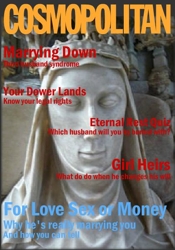

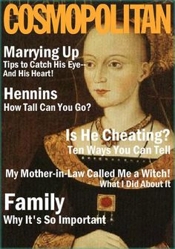
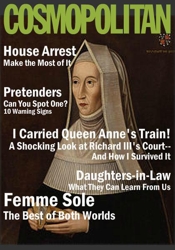
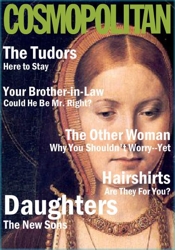
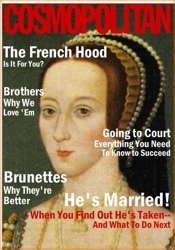

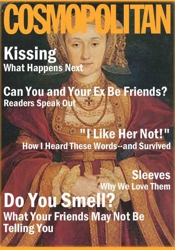



HILDA LEWIS, one of my favourite novelists
Alison Weir
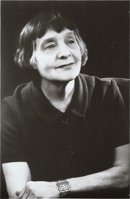

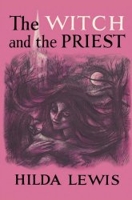


I felt very privileged to have been asked to write a foreward for a reissue of one of Hilda Lewis's novels, as I have been an admirer of Hilda Lewis’s books since the mid-Sixties. They were an inspiration to me when I first discovered a love of history, and they remain so now, informing my work as a historical novelist.
Hilda Winifred Lewis was born in 1896 in London. She began writing at an early age, editing her school and college magazines, then worked as a teacher in London. She married in the early 1920s and moved to Nottingham, where her husband was appointed to the old University College as a lecturer, and later professor, in education. They had one son, Humphrey. Thereafter she devoted herself full-time to writing, enjoying a peaceful existence in the beautiful precincts of the University.
Her first book, Pegasus Yoked, was published in 1933, and told the story of a young woman who felt frustrated by her East End origins but won a scholarship to university and took her first step towards freedom. This was followed by Madam Gold (1933), Full Circle (1935) and Pelican Inn (1937). In all, Hilda Lewis wrote twenty-four adult novels, many of them for my own publishers, Hutchinson and Arrow. She became well known in Nottingham, an unforgettable figure in her long, black, flowing clothes and her commanding voice.
Her modern novels – modern, that is, for the period in which they were written – vividly evoke the vanished world of the early and middle twentieth-century. Some have dark themes, such as Said Dr Spendlove (1946), based on the notorious case of Dr Crippen, and Because I Must (1938), which tells the inevitably grim tale of disturbed Nellie, a girl whose mother was hanged for murder. The Day is Ours (1947), the moving story of a child born deaf and dumb, was made into a highly successful movie, renamed 'Mandy' (1952). Gone to the Pictures (1946) reflects contemporary interest in the silver screen. In Imogen Under Glass (1946), a beautiful invalid snares her sister’s lover, and in Strange Story (1945), a disturbing psychological study of twins, the making of a crime is constructed before the reader's eyes. It was called ‘an unpleasant story- well done’.
Nottingham publisher Five Leaves has reprinted Lewis’s Penny Lace (1946). It is the gritty tale of Nicholas Penny, who starts off working on the factory floor of a local lace factory, but will stop at nothing to become a master. The consequences of his actions and decisions eventually contribute to the demise of the Nottingham lace trade. The character of Nicholas is thought to have influenced the hero in Alan Sillitoe's Saturday Night and Sunday Morning.
Hilda Lewis had always been interested in writing for children, believing that a children's book needed as much, if not more, care than an adult novel. She published four children’s books, of which the most famous is The Ship That Flew (1939), which is about Norse mythology and time travel. It was republished in the Oxford Children's Modern Classics series in 1998. The others were historical novels: Here Comes Harry (1960), about the young Henry VI, Harold Was My King (1968) and The Gentle Falcon (1952), about Richard II’s child bride, Isabella of Valois. This was described by one reviewer as ‘a work of outstanding merit' in which Lewis 'once again shows herself prodigiously equipped to bring to history a view which is both emotionally and intellectually vigorous’.
I myself became acquainted with the work of Hilda Lewis when I came across her stunning, well-researched historical novels. I was riveted by Wife to the Bastard (1966), about Matilda of Flanders, who married William the Conqueror. It is one of the finest examples of historical fiction I have read. Lewis’s trilogy, I Am Mary Tudor (1971), Mary the Queen (1973) and Bloody Mary (1974), is a masterpiece. Her style of writing particularly lent itself to the genre; her language – always a challenge in historical novels – works well for every period and for the modern reader. One feels, after reading these books that one has been on a psychological journey. Rarely have historical novels been underpinned by such power and authenticity. The pace, and the depth, are breathtaking. These books set a benchmark for anyone writing historical fiction today.
Harlot Queen (1970) dramatically reconstructs the life of Isabella of France, queen of Edward II, with a wonderful twist to the tale. Wife to Henry V (1954) is the poignant story of Katherine of Valois, I, Jacqueline the shocking tale of Jacqueline of Hainault, an oppressed medieval princess who endured a terrible existence. The Witch and the Priest (1956) is a compelling account of the witches of Belvoir, a celebrated seventeenth century Lincolnshire case. Wife to Great Buckingham (1959) and Wife to Charles II (1965) recount the lives of Katherine Manners and Catherine of Braganza, two great ladies of the seventeenth century. A Mortal Malice (1963) (about the poisoning of Sir Thomas Overbury) and Call Lady Purbeck (1961) - a horrific tale of female oppression - brilliantly explore two great seventeenth-century scandals. Lewis’s last books, Rose of England (1977) and Heart of a Rose (1978), both about Henry VIII’s sister, Mary Tudor, were published posthumously.
Hilda Lewis died in 1974. Sadly, most of her work is now out of print. On my suggestion, The History Press recently reprinted four of her books in Britain, and I commend Valancourt Books for reissuing The Witch and the Priest. Now that the historical novel has come back into fashion and there is a taste for all things retro, it is good to see Hilda Lewis’s books being made available for a new audience, who can now discover the joys, and the integrity, of her writing, and see for themselves why she became one of the best-known and best-loved of all historical novelists.
